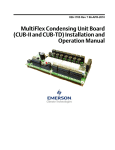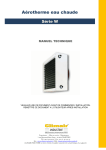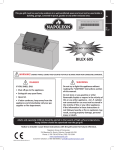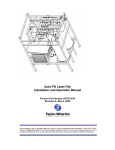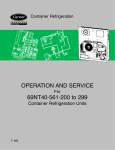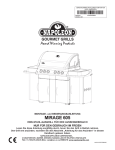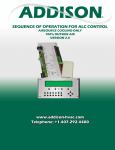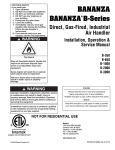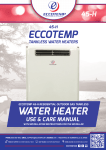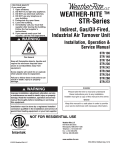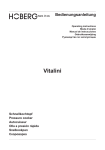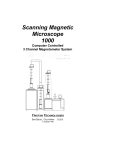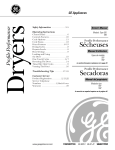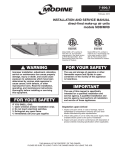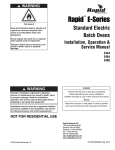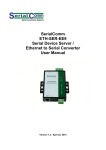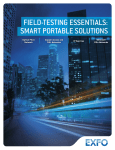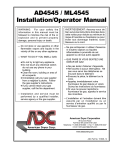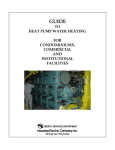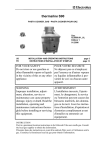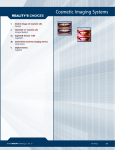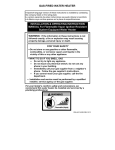Download ADDISON® PR-Series Packaged Rooftop Unit Installation
Transcript
FOR YOUR SAFETY If you smell gas: 1. Open windows. 2. DO NOT try to light any appliance. 3. DO NOT use electrical switches. 4. DO NOT use any telephone in your building. 5. Extinguish any open flame. 6. Leave the building. 7. Immediately call your local fuel supplier after leaving the building. Follow the fuel supplier’s instructions. 8. If you cannot reach your fuel supplier, call the Fire Department. ADDISON PR-Series Packaged Rooftop Unit WARNING ® Installation, Operation & Service Manual PR 036 PR 048 PR 060 PR 072 PR 084 PR 096 PR 120 PR 150 PR 180 Fire Hazard Keep all flammable objects, liquids and vapors the minimum required clearances to combustibles away from equipment. Some objects will catch fire or explode when placed close to equipment. Failure to follow these instructions can result in death, injury or property damage. Installer WARNING Improper installation, adjustment, alteration, service or maintenance can result in death, injury or property damage. Read the installation, operation and service manual thoroughly before installing or servicing this equipment. Installation must be done by a registered installer/ contractor qualified in the installation and service of air conditioning equipment. PR 210 PR 240 PR 300 PR 360 PR 420 PR 480 PR 540 PR 600 PR 660 Please take the time to read and understand these instructions prior to any installation. Installer must give a copy of this manual to the owner. Owner Keep this manual in a safe place in order to provide your service technician with necessary information. NOT FOR RESIDENTIAL USE Addison 7050 Overland Road Orlando, FL 32810 Telephone: +1.407.292.4400 Fax: +1.407.290.1329 www.addison-hvac.com © 2014 Addison P/N AD165000NA Orig. 07/14 POUR VOTRE SECURITE Si vous sentez une odeur de gaz: 1. Ouvrir les fenêtres. 2. N’essayer pas d’allumer un appareil. 3. N’utiliser pas d’interrupteurs électriques. 4. N’utiliser pas de téléphone dans votre bâtiment. 5. Eteindre flamme nue. 6. Quitter le bâtiment. 7. Après avoir quitté le bâtiment, appelez immédiatement votre fournisseur local de gaz. Suivre les instructions du fournisseur de gaz. 8. Si vous ne pouvez pas joindre votre fournisseur de gaz, appeler le service d’incendie. AVERTISSEMENT ADDISON PR-Series ® L’appareil emballé pour la climatisation Manuel d'installation, d'opération, et d'entretien PR 036 PR 048 PR 060 PR 072 PR 084 PR 096 PR 120 PR 150 PR 180 Risque d’incendie Garder tous les objets, liquides ou vapeurs inflammables à la distance minimale de l’unité de chauffage requise avec les matériaux combustibles. Certains objets prendront feu ou exploseront s’ils sont placés à proximité de l’unité de chauffage. Le non respect de ces instructions peut entraîner la mort, des blessures corporelles ou des dommages matériels. AVERTISSEMENT PR 210 PR 240 PR 300 PR 360 PR 420 PR 480 PR 540 PR 600 PR 660 Installateur L’installation, le réglage, la modification, la réparation ou la maintenance inadapté peut entraîner la mort, des blessures ou des dommages matériels. Lire attentivement le manuel d'installation, d'utilisation et d'entretien avant d’installer ou de réparer cet équipement. Vouloir prendre le temps de lire et de comprendre ces L’installation doit être effectuée par un entrepreneur qualifié dans l'installation et l'entretien d'appareils de chauffage au gaz ou par votre fournisseur de gaz. Garder ce manuel dans un endroit sûr pour fournir les instructions avant toute installation. L’installateur doit donner un exemplaire de ce manuel au propriétaire. Propriétaire informations nécessaires au personnel d’entretien. Conçus pour les applications non-résidentielles Addison 7050 Overland Road Orlando, FL 32810 Téléphone: +1.407.292.4400 Fax: +1.407.290.1329 www.addison-hvac.com © 2014 Addison P/N AD165000FC Orig. 07/14 TABLE OF CONTENTS SECTION 1: Packaged Rooftop Unit Safety.......................... 1 1.1 Description of Operation............................................... 1 1.2 Inspection and Setup ................................................... 1 1.3 Safety Labels and Their Placement ............................. 1 1.4 California Proposition 65 .............................................. 2 SECTION 2: Installer Responsibility ..................................... 3 2.1 Corrosive Chemicals.................................................... 3 2.2 Required Equipment and Materials.............................. 3 SECTION 3: Critical Considerations ..................................... 4 3.1 Required Clearances ................................................... 4 3.2 Placement Considerations........................................... 4 3.3 Hardware ..................................................................... 4 SECTION 4: National Standards and Applicable Codes ..... 5 4.1 Refrigerant Handling Practices .................................... 5 4.2 Fuel Codes................................................................... 5 4.3 Installation Codes ........................................................ 5 4.4 Aircraft Hangars ........................................................... 5 4.5 Parking Structures and Repair Garages ...................... 5 4.6 Electrical ...................................................................... 5 4.7 Venting......................................................................... 5 4.8 High Altitude ................................................................ 5 SECTION 5: Specifications .................................................... 6 SECTION 6: Lifting a Packaged Air Conditioning Unit ........ 7 6.1 Moving/Lifting a Packaged Air Conditioning Unit ......... 7 SECTION 7: Roof Curb ........................................................... 9 7.1 Roof Curb Assembly and Installation ........................... 9 7.2 Unit Mounting to Roof Curb ........................................ 10 SECTION 8: Duct Considerations........................................ 11 8.1 Inlet Ductwork............................................................ 11 8.2 Return Air Ductwork .................................................. 11 8.3 Discharge Ductwork .................................................. 11 SECTION 9: Refrigeration Circuits ...................................... 12 9.1 Refrigerant ................................................................. 12 9.2 Components and Configurations ............................... 12 SECTION 10: Energy Conservation Wheels ....................... 20 10.1 Principal of Operation............................................... 20 SECTION 11: Gas Furnaces.................................................. 21 11.1 Principle of Operation ............................................... 22 11.2 Gas Piping and Pressure .......................................... 22 11.3 Operating and Safety Controls.................................. 22 11.4 Wiring........................................................................ 23 11.5 Sequence of Operation............................................. 28 SECTION 12: Electric Heaters.............................................. 32 12.1 Principle of Operation............................................... 33 12.2 Operating and Safety Controls................................. 33 12.3 Wiring....................................................................... 33 SECTION 13: Electrical ......................................................... 34 13.1 Wiring and Electrical Connections ........................... 34 13.2 Disconnect ............................................................... 34 13.3 Current Draw............................................................ 34 13.4 Wiring Connections.................................................. 34 SECTION 14: Sequence of Operation ................................. 35 14.1 Unit Configuration .................................................... 35 14.2 Controls Options ...................................................... 36 14.3 Basic Sequence of Operation.................................. 37 14.4 Controls Options ...................................................... 37 SECTION 15: Start-up Procedures ...................................... 38 15.1 Pre-Start Checks ..................................................... 39 SECTION 16: Maintenance................................................... 41 16.1 General.................................................................... 42 16.2 Unit Exterior ............................................................. 42 16.3 Direct-Drive Supply and Exhaust Fans .................... 43 16.4 Condensing Fans..................................................... 43 16.5 Refrigeration Circuit Components............................ 43 16.6 Condensate Drain Pan and Drain ............................ 44 16.7 Dampers .................................................................. 44 16.8 Energy Conservation Wheel .................................... 44 16.9 Gas Furnace ............................................................ 45 16.10 Electric Heater Wiring and Wiring Connections ..... 46 16.11 Filters ..................................................................... 46 SECTION 17: Replacement Parts ........................................ 47 SECTION 18: Troubleshooting............................................. 48 18.1 Supply Fan............................................................... 49 18.2 Compressor ............................................................. 50 18.3 Refrigeration Circuit ................................................. 52 18.4 Variable Speed Head Pressure Control ................... 55 18.5 Variable Speed Head Pressure Control ................... 56 18.6 Energy Conservation Wheel .................................... 57 18.7 Gas Furnace ............................................................ 58 18.8 Electric Heater ......................................................... 59 18.9 ADDISON® PR-Series Start-Up Procedures............ 60 SECTION 19: The ADDISON® PR-Series Warranty............. 67 © 2014 Addison All rights reserved. No part of this work covered by the copyrights herein may be reproduced or copied in any form or by any means - graphic, electronic, or mechanical, including photocopying, recording, taping or information storage and retrieval systems - without the written permission of Addison. Printed in U.S.A. TABLE DES MATIERES PARTIE 1: Sécurité de l'appareil emballé pour la climatisation .......................................................... 1 1.1 Description de l'opération............................................. 1 1.2 Inspection et installation ............................................... 1 1.3 Etiquettes de sécurité et leur placement ...................... 1 1.4 Proposition 65 de l'état de California ............................ 2 PARTIE 2: Responsabilité de l'installateur ........................... 3 2.1 Produits chimiques corrosifs ........................................ 3 2.2 Equipments et matériels obligatoires ........................... 3 PARTIE 3: Observations importantes ................................... 4 3.1 Espacements obligatoires ............................................ 4 3.2 Observations de placement ......................................... 4 3.3 Considérations pour les boulons and les vis ............... 4 PARTIE 4: Normes nationales et codes applicables............ 5 4.1 Practiques d'utilisation pour le réfrigérant .................... 5 4.2 Codes du gaz............................................................... 5 4.3 Codes d'installation...................................................... 5 4.4 Hangars pour avions ................................................... 5 4.5 Garages publics........................................................... 5 4.6 Electricité ..................................................................... 5 4.7 Evacuation ................................................................... 5 4.8 Altitude Elevée ............................................................. 5 PARTIE 5: Caractéristiques techniques ................................ 6 PARTIE 6: Levage de l'appareil emballé pour la climatisation ............................................................................ 7 6.1 Mouvement et levage de l'appareil emballé pour la climatisation................................................................ 7 PARTIE 7: Structure pour le montage de l'appareil au toit.. 9 7.1 Assemblé et installation de la structure ........................ 9 7.2 Montage de l'appareil à la structure ........................... 10 PARTIE 8: Observations pour la conduite .......................... 11 8.1 Conduite de l'air entrant............................................. 11 8.2 Conduite de l'air retourné........................................... 11 8.3 Conduite de l'air d'alimentation .................................. 11 PARTIE 9: Circuits de réfrigération ..................................... 12 9.1 Réfrigérant ................................................................. 12 9.2 Composants et configurations ................................... 12 PARTIE 10: Roue pour le recuperation d'énergie............... 20 10.1 Principe de fonctionnement...................................... 20 PARTIE 11: Aerothermes de gas .......................................... 21 11.1 Principe de fonctionnement ...................................... 22 11.2 Conduites et pressions de gaz.................................. 22 11.3 Contrôles de fonctionnement and de sécurité .......... 22 11.4 Câblage .................................................................... 23 11.5 Séquence de fonctionnement ................................... 28 PARTIE 13: Aerothermes electriques .................................. 32 12.1 Principe de fonctionnement...................................... 33 12.2 Contrôles de fonctionnement and de sécurité.......... 33 12.3 Câblage.................................................................... 33 12.4 Séquence de fonctionnement .................................. 34 PARTIE 13: Electricité........................................................... 35 13.1 Connections de câblage et électrique...................... 35 13.2 Déconnexion électrique ........................................... 35 13.3 Consumption du courant ......................................... 35 13.4 Connections de câblage .......................................... 35 PARTIE 14: Séquence de fonctionnement.......................... 36 14.1 Configuration de l'appareil ....................................... 36 14.2 Options pour les contrôles ....................................... 37 14.3 Séquence de fonctionnement .................................. 38 14.4 Options pour les contrôles ....................................... 38 PARTIE 15: Procedures de démarrage................................ 39 15.1 Vérifications avant de démarrage ............................ 40 PARTIE 16: Maintenance ...................................................... 42 16.1 Général.................................................................... 43 16.2 Extérieur de l'appareil .............................................. 43 16.3 Ventilateurs d'alimentation et d'évacuation .............. 44 16.4 Ventilateurs de condenseur ..................................... 44 16.5 Composants de circuits de réfrigération .................. 44 16.6 Collecteur de condensat .......................................... 44 16.7 Amortissuers............................................................ 45 16.8 Roue pour le recuperation d'énergie........................ 45 16.9 Aerotherme de gas .................................................. 46 16.10 Aerotherme electrique............................................ 47 16.11 Filtres ..................................................................... 47 PARTIE 17: Pièces de rechange .......................................... 48 PARTIE 18: Dépannage ........................................................ 49 18.1 Ventilateur d'alimentation ........................................ 50 18.2 Compresseur ........................................................... 51 18.3 Circuit de réfrigération ............................................. 53 18.4 Contrôle de la vitesse variable pour les ventilateurs de condenseur........................................................ 56 18.5 Contrôle de la vitesse variable pour les ventilateurs de condenseur........................................................ 57 18.6 Roue pour le recuperation d'énergie........................ 58 18.7 Aerotherme de gas .................................................. 59 18.8 Aerotherme electrique ............................................. 60 18.9 Procedures de démarrage pour ADDISON® PR-Séries ............................................................... 61 PARTIE 19: Garantie de ADDISON® PR-Séries ................... 69 © 2014 Addison Tous droits réservés. Aucune partie de ce document couvert par le copyright ne peut être copiée ou reproduite de quelque manière que ce soit (graphique, électronique ou mécanique), y compris photocopie, enregistrement sur bande magnétique, ou stockage et extraction dans des systèmes informatisés, sans l'autorisation écrite préalable de Addison. Printed in U.S.A. TABLE OF FIGURES Figure 1: Label Placement Drawing .......................................... 2 Figure 2: Lifting a Small Unit ..................................................... 8 Figure 3: Lifting a Large Unit ..................................................... 8 Figure 4: Curb Mounting ......................................................... 10 Figure 5: Circuit Diagram for Standard Compressor and Hot Gas Bypass and No Hot Gas Reheat ................... 13 Figure 6: Circuit Diagram for Standard Compressor, Hot Gas Bypass and Standard Hot Gas Reheat.................. 14 Figure 7: Circuit Diagram for Standard Compressor, Hot Gas Bypass and Modulating Hot Gas Reheat............... 15 Figure 8: Circuit Diagram for Digital Compressor and Modulating Hot Gas Reheat.................................. 16 Figure 9: Circuit Diagram for Standard Compressor, Hot Gas Bypass, Standard Hot Gas Reheat and Sub-Cooling .......................................................... 17 Figure 10: Circuit Diagram for Standard Compressor, Hot Gas Bypass, Modulating Hot Gas Reheat and Sub-Cooling .......................................................... 18 Figure 11: Circuit Diagram for Digital Compressor, Modulating Hot Gas Reheat and Sub-Cooling ........................ 19 Figure 12: Wiring Diagram for FM-Compliant Two-Stage Furnace with 75-200 MBH (21.9-58.6kW) Input ... 24 Figure 13: Wiring Diagram for FM-Compliant Two-Stage Furnace with 250-400 MBH (73.3-117.2 kW) Input ..................................................................... 25 Figure 14: Wiring Diagram for FM-Compliant 20-100% Modulating Furnace with 75-200 MBH (21.9-58.6kW) Input............................................... 26 Figure 15: Wiring Diagram for FM-Compliant 20-100% Modulating Furnace with 250-400 MBH (73.3-117.2 kW) Input ............................................ 27 Figure 16: Wiring Diagram ...................................................... 33 Figure 17: Unit Configuration .................................................. 35 Figure 18: P-Trap.................................................................... 39 LIST OF TABLES Table 1: Recommended Torque Settings ................................. 4 Table 2: Manifold Size and Minimum Pressures..................... 22 Table 3: Gas Furnace Inlet and Manifold Pressures............... 40 Table 4: Motor Lubrication Intervals........................................ 43 There are references in this manual to various trademarks. All trademarks mentioned herein, whether registered or not, are the property of their respective owners. Addison is not sponsored by or affiliated with any of the trademark or registered trademark owners, and makes no representations about them, their owners, their products or services. SECTION 1: PACKAGED ROOFTOP UNIT SAFETY SECTION 1: PACKAGED ROOFTOP UNIT SAFETY Your Safety is Important to Us! This symbol is used throughout the manual to notify you of possible fire, electrical or burn hazards. Please pay special attention when reading and following the warnings in these sections. Installation, service and at a minimum, quarterly inspection of packaged rooftop unit must be done by a contractor qualified in the installation and service of air conditioning equipment. Read this manual carefully before installation, operation or service of this equipment. These instructions, local codes and ordinances and applicable standards that apply to piping, electrical wiring, ventilation, etc. must be thoroughly understood before proceeding with the installation. Protective gear is to be worn during installation, operation and service in accordance to the Occupational Safety and Hazard Administration (OSHA). Gear must be in accordance to NFPA 70E, latest revision when working with electrical components. Thin sheet metal parts have sharp edges. To prevent injury, the use of work gloves is recommended. Before installation, check that the electrical supply and/or fuel conditions and adjustment of the equipment are compatible. This equipment must be applied and operated under the general concepts of reasonable use and installed using best building practices. This equipment is not intended for use by persons (including children) with reduced physical, sensory or mental capabilities, or lack of experience and knowledge, unless they have been given supervision or instruction concerning use of the equipment by a person responsible for their safety. Children should be supervised to ensure that they do not play with the equipment. For additional copies of the Installation, Operation and Service Manual, please contact Addison. Optional gas furnace in this equipment is not designed for use in atmospheres containing flammable vapors, flammable dust or chlorinated or halogenated hydrocarbons. Recirculated room air may be hazardous if containing flammable solids, liquids, and gases; explosive materials; and/or substances which may become toxic when exposed to heat (i.e. refrigerants, aerosols, etc.). 1.1 Description of Operation The PR-Series unit is a factory-assembled packaged system that can operate within a broad range of ambient conditions and introduce ventilation air into a building at neutral conditions. It consists of matched refrigeration and air moving components (system controls, compressor[s], evaporator section, condensing section and fan[s]) designed to treat 100% outside air and/or recirculated air. This system has the ability to filter, cool, heat, and/or dehumidify air. The unit may be provided with several different options and/or controls to meet various application requirements, including optional hot gas reheat, energy recovery wheel, supplemental heat (gas, electric hot water or steam) and variable air volume delivery. Be sure to read this entire manual before installation and start-up. 1.2 Inspection and Setup The unit was leak-tested, pressure-tested, evacuated, charged and run-tested prior to shipment. Immediately upon receipt of the unit, check the electrical supply and/or fuel characteristics of the unit and verify that they match the electrical supply and/or fuel available. Verify that the specifications on the unit rating plate match your order. Check the unit for any damage that may have occurred during shipment. If any damage is found, file a claim with the transporting agency. Do not refuse shipment. Check the installation location to ensure proper clearances. See Page 4, Section 3. Any small options which do not come attached to the unit (i.e. sensors) will be found inside the unit control enclosure. If the unit must be temporarily stored (i.e. job site is not ready for installation of the unit), the unit should be set on 4" x 4" (10 cm x 10 cm) pieces of timber on the ground in a protected area. The unit should be covered to be protected from the environment. 1.3 Safety Labels and Their Placement Product safety signs or labels should be replaced by product user when they are no longer legible. Please contact Addison or your ADDISON® independent distributor to obtain replacement signs or labels. See Page 2, Figure 1. 1 of 67 PR-SERIES INSTALLATION, OPERATION AND SERVICE MANUAL 1.4 California Proposition 65 label location. Avoid placing label on areas with extreme heat, cold, corrosive chemicals or other elements. To order additional labels, please contact Addison or your ADDISON® independent distributor. In accordance with California Proposition 65 requirements, a warning label must be placed in a highly visible location on the outside of the equipment (i.e., near equipment’s serial plate). See label placement drawings on Page 2, Figure 1 for FIGURE 1: Label Placement Drawing 9 2 7 3 4 8 1 6 5 1 5 9 3 4 Item Part Number 1 0527P-1286 2 91070002 3 91070001 4 91070004 5 91070005 6 91070006 7 91010432 8 91010431 9 91070002 2 of 67 Description Logo Label Severe Injury Hazard Label Electric Shock Hazard Label Fire Hazard Label Fall Hazard Label Burn Hazard Label PR Lighting Instruction Label Improper Installation Warning Label Severe Injury Hazard Label 6 Notes Applies only to units with supplemental heater. Applies only to units with supplemental heater. Applies only to units with gas-fired supplemental heater. Applies only to units with gas-fired supplemental heater. Applies only to airsource units. SECTION 2: INSTALLER RESPONSIBILITY SECTION 2: INSTALLER RESPONSIBILITY WARNING Explosion Hazard 2.1 Corrosive Chemicals CAUTION Product Damage Hazard Equipment must have access to uncontaminated air at all times. Do not use equipment in area containing corrosive chemicals. Failure to follow these instructions can result in death, injury or property damage. Refer to appropriate Material Safety Data Sheets (MSDS). The installer is responsible for the following: • To install and commission the unit, as well as the fuel and electrical supplies, in accordance with applicable specifications and codes. Addison recommends the installer contact a local building inspector for guidance. • To use the information given in a layout drawing and in the manual together with the cited codes and regulations to perform the installation. • To furnish all needed materials not furnished as standard equipment. • To plan location of supports. • To provide access to unit for servicing. • To provide the owner with a copy of this Installation, Operation and Service Manual. • To ensure there is adequate air circulation around the unit and to supply air for combustion, ventilation and distribution in accordance with local codes. • To assemble or install any accessories or associated duct work using best building practices. • To properly size supports and hanging materials. • To verify that the unit is delivering design airflow by having an air balancing test performed. • To have refrigerant technician certification per Section 608 of the US Environmental Protection Agency (EPA) Clean Air Act of 1990 or equivalent certification program. • To have all required equipment to work on direct expansion and/or chilled water air conditioning system. Failure to follow these instructions can result in product damage. Addison cannot be responsible for ensuring that all appropriate safety measures are undertaken prior to installation; this is entirely the responsibility of the installer. It is essential that the contractor, the subcontractor, or the owner identifies the presence of combustible materials, corrosive chemicals or halogenated hydrocarbons* anywhere in the premises. * Halogenated Hydrocarbons are a family of chemical compounds characterized by the presence of halogen elements (fluorine, chlorine, bromine, etc.). These compounds are frequently used in refrigerants, cleaning agents, solvents, etc. If these compounds enter the air supply of the burner, the life span of the unit components will be greatly reduced. An outside air supply must be provided to the burners whenever the presence of these compounds is suspected. Warranty will be invalid if the unit is exposed to halogenated hydrocarbons. 2.2 Required Equipment and Materials When lifting of the unit is required, the installing contractor is responsible for supplying or arranging for the appropriate lifting equipment so that the unit may be placed in a safe manner. The qualified installing / service technician is responsible for having the appropriate equipment and materials for the safe installation and start-up of an unit. Tools and materials required to commission the unit include, but are not limited to, the following: • Various screwdriver types and sizes • Various wrench types and sizes • Drill motor and various drill bits • Voltmeter • Clamp style ammeter • Butyl caulk • Gauges and accessories • Direct expansion and/or chilled water gauges and accessories. 3 of 67 PR-SERIES INSTALLATION, OPERATION AND SERVICE MANUAL SECTION 3: CRITICAL CONSIDERATIONS 3.1 Required Clearances Clearances are the required distances that the unit must be away from objects and other units to allow service access and proper operation of the unit. 3.1.1 Service Clearances Minimum clearance for service is 48" (121.9 cm) on all sides of unit. 3.1.2 Ventilation Clearances In order to help ensure proper operation of an airsource unit, a 24" (61.0 cm) clearance for ventilation must be maintained. In addition, read and follow the additional ventilation clearance guidelines below: • Do not locate the unit under an overhang or near a wall/other equipment that will short circuit hot air to the coil intakes. • Do not locate unit within 10’ (3.0 m) of exhaust fans or flues. • Do not locate the unit too close to another unit to allow air recirculation. structural members supporting the unit must be sufficiently strong for the weight of the unit and mounting rails. 3.3 Hardware Unless otherwise specified, all hardware (except sheet metal screws) must be torqued to settings from Page 4, Table 1 Table 1: Recommended Torque Settings Bolt Head Grade Marking Nut Grade Marking 3.2 Placement Considerations The unit is typically mounted on a curb with ductwork and utility connections usually going through the curb. It may also be pad-mounted. (Contact factory for specific instructions if unit is to be mounted in a different way [ie. on mounting stand].) Select a location where external water drainage cannot collect around the unit. Locate the unit so roof runoff water does not pour directly on the unit. Provide gutter or other shielding at roof level. Where snowfall is anticipated, mount the unit so all intakes and discharges are above the maximum snow depth for the area. Unit shall not be installed with inlet opening facing into the prevailing wind direction in order to help prevent the possibility of moisture entrainment. When installed at ground level, the unit should be mounted on a level concrete slab which should extend at least 2" (5.1 cm) beyond the unit on all sides. The top of the slab should be 2" (5.1 cm) above the ground level. The depth of the slab below the ground level and its structural design is governed by the type of soil and climatic conditions. The slab must not be in contact with any part of the building wall or foundation. The space between the slab and the building wall prevents the possibility of transmitting vibration to the building. When installing a unit on the roof of a building, the 4 of 67 Bolt Size 10-24 1/4-20 5/16-18 3/8-16 Bolt Head Grade Marking Grade 2 27 in•Lb 65 in•Lb 11 ft•Lb 19 ft•Lb Grade 5 42 in•Lb 101 in•Lb 17 ft•Lb 30 ft•Lb 8.8 10.9 8.8 10.9 Grade 8.8 6Nm 10Nm 25Nm 50Nm 85Nm 215Nm Grade 10.9 9Nm 15Nm 35Nm 75Nm 130Nm 315Nm Nut Grade Marking Bolt Size M5 M6 M8 M10 M12 M16 SECTION 4: NATIONAL STANDARDS AND APPLICABLE CODES SECTION 4: NATIONAL STANDARDS AND APPLICABLE CODES 4.1 Refrigerant Handling Practices 4.5 Parking Structures and Repair Garages Installation in garages must be in accordance with the following codes: The handling, reclaiming, recovering and recycling of refrigerants as well as the equipment to be used and the procedures to be followed must comply with the national and local codes. United States: Standard for Parking Structures NFPA 88A - latest revision or the Code for Motor Fuel Dispensing Facilities and Repair Garages, NFPA 30A - latest revision. United States: Refer to Federal Clean Air Act latest revision. Canada: Refer to CSA B149.1 - latest revision, Natural Gas and Propane Installation Code. Canada: Refer to Canadian Environmental Protection Act - latest revision. 4.2 Fuel Codes The type of fuel appearing on the nameplate must be the type of fuel used. Installation must comply with national and local codes and requirements of the local fuel company. United States: Refer to NFPA 54/ANSI Z223.1 latest revision, National Fuel Gas Code. Canada: Refer to CSA B149.1 - latest revision, Natural Gas and Propane Installation Code. 4.6 Electrical Electrical connection to unit must be in accordance with the following codes: United States: Refer to National Electrical Code®, NFPA 70 - latest revision. Wiring must conform to the most current National Electrical Code®, local ordinances, and any special diagrams furnished. Canada: Refer to Canadian Electrical Code, CSA C22.1 Part 1 - latest revision. 4.7 Venting 4.3 Installation Codes Installations must be made in accordance with NFPA 90A - latest revision, Standard for the Installation of Air-Conditioning and Ventilation Systems. 4.4 Aircraft Hangars Installation in aircraft hangars must be in accordance with the following codes: United States: Refer to Standard for Aircraft Hangars, NFPA 409 - latest revision. Canada: Refer to Standard CSA B149.1 - latest revision, Natural Gas and Propane Installation Code. The optional gas furnace in the unit must be vented in accordance with the requirements within this manual and with the following codes and any state, provincial or local codes which may apply: United States: Refer to NFPA 54/ANSI Z223.1latest revision, National Fuel Gas Code. Canada: Refer to CSA B149.1 - latest revision, Natural Gas and Propane Installation Code. 4.8 High Altitude The optional gas furnace in the unit is approved for installations up to 2000' (609.6 m) (US), 4500'(1371.6 m) (Canada) without modification. Consult factory if US installation is above 2000' (609.6 m) or Canadian installation is above 4500’(1371.6 m). 5 of 67 PR-SERIES INSTALLATION, OPERATION AND SERVICE MANUAL SECTION 5: SPECIFICATIONS All specification, dimension and weight information is available in the PR-Series Dimension and Selection Guides that can be downloaded from the ADDISON® website at www.addison-hvac.com. 6 of 67 SECTION 6: LIFTING A PACKAGED AIR CONDITIONING UNIT SECTION 6: LIFTING A PACKAGED AIR CONDITIONING UNIT WARNING Crush Hazard Use proper lifting equipment and practices. Failure to follow these instructions can result in death, injury or property damage. 6.1.2 Moving the Unit with Forklift Move the unit using forklift pockets, if provided. 6.1.3 Lifting the Unit with Crane Lift the unit into place installing appropriate hardware (supplied by others) into all four lifting lugs holes. Use spreader bars to ensure that the lifting cables clear the sides of the unit. See Page 8, Figure 2. Test lift to 12"(30.5 cm) to check stability of rigging before completing the lift. Use caution as the load may be unbalanced. The unit must be kept level during the lift to prevent tipping, twisting or falling. If lifted improperly, product damage may occur. The unit must be installed in compliance with all applicable codes. The qualified installer or service technician must use best building practices when installing the unit. 6.1 Moving/Lifting a Packaged Air Conditioning Unit 6.1.1 Preparing to Move/Lift the Unit: Prior to moving/lifting the unit, the following steps must be performed. 1. Remove all packaging or blockers. 2. Remove all packages that were shipped inside the unit. 3. Inspect the unit to: • Verify that there is no damage as a result of shipping. • Ensure that it is appropriately rated for the utilities available at the installation site. • Verify that the lifting lugs are intact, undamaged and secured to the packaged air conditioning unit. • Ensure factory-installed hardware is torqued as specified. 4. Prepare the installation location to be ready to accept the unit (i.e. roof curb is correct size). 5. Verify that the moving/lifting equipment can handle the unit’s weight. Verify that forklift forks extend through the unit frame and that crane has required reach. 7 of 67 PR-SERIES INSTALLATION, OPERATION AND SERVICE MANUAL FIGURE 2: Lifting a Small Unit Fixed Lifting Source Adjust Cable Length To Lift Point As Necessary Based On Unit Center Of Gravity Spreader Bar Fixed Cable Shackle With Minimum 1.25” (3.2cm) Pin NOTE: Airsource packaged unit is illustrated. Lifting procedures for watersource packaged units and air handlers are similar. FIGURE 3: Lifting a Large Unit Fixed Lifting Source Adjust Cable Length To Lift Point As Necessary Based On Unit Center Of Gravity Spreader Bar Rolling Block 20' (6.1m) Cable Through Rolling Block Shackle With Minimum 1.25” (3.2cm) Pin Hook To Rail NOTE: Airsource packaged unit is illustrated. Lifting procedures for watersource packaged units and air handlers are similar. 8 of 67 SECTION 7: ROOF CURB SECTION 7: ROOF CURB WARNING Crush Hazard Use proper lifting equipment and practices. Falling Hazard Use proper safety equipment and practices to avoid falling. Severe Injury Hazard Cut/Pinch Hazard Use proper lifting practices and equipment. Wear protective gear during installation, operation and service. Equipment and accessories are heavy. Edges are sharp. Failure to follow these instructions can result in death, injury or property damage. Roof curbs are available for unit that are to be installed on a typical flat roof (ie. bonded or corrugated) with no seismic restraint requirements. (If seismic restraint is required, contact factory.) Curb dimension and weight information is available in the PR-Series Dimension and Selection Guides that can be downloaded from the ADDISON® website at www.addison-hvac.com. Note: Before installation, verify that you have the correct roof curb and that all required components are present. If any are missing, contact your ADDISON® independent representative. 7.1 Roof Curb Assembly and Installation Place the curb on the roof in the position in which it will be installed. Check that the diagonal measurements are within 1/16"(1.6 mm) of each other. To ensure a weatherproof seal between the unit and the curb, the curb must be level with no twist from end to end. Shim level as required and secure curb to roof deck using best building practices. Inspect curb to ensure that none of the field piping routed through the curb protrude above the curb. Install roofing material as required. NOTE: Check the installation location to ensure proper clearances to combustibles and clearance for access. See Page 4, Section 3. 9 of 67 PR-SERIES INSTALLATION, OPERATION AND SERVICE MANUAL 7.2 Unit Mounting to Roof Curb After the curb has been installed, the unit may be placed on the curb. There must be a 3/8" (0.95 cm) x 2" (5.1 cm) closed cell neoprene insulation (supplied by others) between the top of the curb and the base surface of the unit to prevent moisture from leaking into the building (ie. from driving rains or melting snow.) the curb per all applicable codes. See Page 10, Figure 4 for details. The installer is responsible for attaching the unit to FIGURE 4: Curb Mounting 3/8” (0.95cm) x 2” (5.1 cm) Closed Cell Neoprene Insulation (Field Supplied) Butyl Caulk Seal (Field Supplied) 2” x 4” (5cm x 10cm) Treated Wood Nailer With Curb Bottom Pan Unit 12 Gauge Channel 6” (16.5cm) 14” (35.6cm) Rigid Insulation Field Supplied 1/2” (1.3 cm) Nom. Counter Flashing & Cant Strip, Field Supplied Roof Deck and Roofing Field Supplied (Typical) 10 of 67 SECTION 8: DUCT CONSIDERATIONS SECTION 8: DUCT CONSIDERATIONS The unit has been designed to operate at the specific air volume and external static pressure that was ordered. This static pressure is generated by any additional components that are added to the unit (i.e. ductwork, etc). Additional static pressure beyond that ordered will affect the performance of the packaged air conditioning unit and lessen the air volume that can be delivered. Proper engineering methods need to be employed when calculating duct and component static pressure (i.e. 2009 ASHRAE Handbook - Fundamentals, Chapter 21). The system ductwork must comply with Sheet Metal and Air Conditioning Contractors National Association (SMACNA) or any other recognized standards. vapor barrier) to prevent unnecessary energy losses and/or condensation. 8.1 Inlet Ductwork Inlet ductwork height and width must be no smaller than the packaged air conditioning unit inlet height and width and supply only uncontaminated air to the unit. 8.2 Return Air Ductwork Return air ductwork height and width must be no smaller than the unit return air opening height and width. 8.3 Discharge Ductwork Discharge air ductwork height and width must be no smaller that the unit discharge air opening height and width. It is recommended that flexible duct connections be incorporated into the ductwork design to prevent the transmission of any vibrations, either mechanical or harmonic. As a general rule, all ducts should have a straight run of at least 3 hydraulic duct diameters immediately before and after the unit before adding any fittings, elbows, restrictions, etc. Hydraulic duct diameter for round ducts (in inches): Dh = d Dh: hydraulic diameter d: round duct inside diameter Hydraulic duct diameter for rectangular ducts (in inches): Dh = (2*H*W)/(H+W) Dh: hydraulic diameter H: rectangular duct inside height W: rectangular duct inside width The unit is not designed to support the weight of ductwork. Ductwork must be constructed in a fashion that is self-supporting. Depending on the options ordered with the unit, flanges (either external or internal) may be provided to facilitate connection of ductwork. In cases where flanges are not provided, flat surfaces on the exterior skin of the unit are provided to facilitate connection of ductwork. Neither the flanges nor exterior skin of the unit are capable of supporting the load of the ductwork. Ductwork support must come from the structure itself that the unit is servicing. Ductwork passing through unconditioned spaces must be insulated (including a 11 of 67 PR-SERIES INSTALLATION, OPERATION AND SERVICE MANUAL SECTION 9: REFRIGERATION CIRCUITS WARNING Explosion Hazard System contains R-410A refrigerant. Operating pressures may exceed limits of R-22 service equipment. Use proper refrigerant handling practices, tools and equipment. Failure to follow these instructions can result in death, injury or property damage. CAUTION Equipment Damage Hazard System contains R-410A refrigerant. Operating pressures may exceed limits of R-22 service equipment. Use only R-410A refrigerant and POE 3MAF compressor oil. Failure to follow these instructions can result in equipment damage. 9.1 Refrigerant This unit utilizes R-410A, a refrigerant with a very low ozone depletion rating. Equipment utilizing R-410A refrigerant operates at higher pressures than other typical refrigerants. System components have been sized and pressure switch settings have been adjusted for the reduced refrigerant flows and higher operating pressures. The unit has a broad application range. For optimum performance and efficiency, it may be necessary to adjust the refrigerant charge to maintain desired 12 of 67 subcooling and superheat at operating temperature extremes. 9.2 Components and Configurations There are many different refrigeration circuit variations available. Depending on the configuration, the unit may include, but is not limited to, the following components: • Accumulator • Coil • Evaporator coil • Condenser coil • Coaxial coil • Compressor • Standard scroll • Digital scroll • Filter drier • Hot gas bypass valve • Hot gas reheat components • Check valve • Coil • Solenoid valve (standard) or modulating bypass/reheat valves (modulating) • Oil separator • Receiver • Refrigerant pressure switches- high and low • Non-adjustable • Adjustable • Switchable liquid sub-cooling components • Coil • Two solenoid valves • Check valve • Thermal expansion valve (TXV) See Page 13, Figure 5 through Page 19, Figure 11 for schematics of the most common refrigeration circuit configurations. All schematics illustrate a single-compressor, single-circuit, cooling-only system • For single-circuit systems with a tandem compressor, the pair of compressors are mounted on a common base that are used together on a single refrigeration circuit. • For dual-circuit systems with two independent compressors, the circuitry and components are duplicated for the second circuit. • For heat-pump systems, a reversing valve is included. SECTION 9: REFRIGERATION CIRCUITS FIGURE 5: Circuit Diagram for Standard Compressor and Hot Gas Bypass and No Hot Gas Reheat Airsource Units Watersource Units 13 of 67 PR-SERIES INSTALLATION, OPERATION AND SERVICE MANUAL FIGURE 6: Circuit Diagram for Standard Compressor, Hot Gas Bypass and Standard Hot Gas Reheat Airsource Units Watersource Units 14 of 67 SECTION 9: REFRIGERATION CIRCUITS FIGURE 7: Circuit Diagram for Standard Compressor, Hot Gas Bypass and Modulating Hot Gas Reheat Airsource Units Watersource Units 15 of 67 PR-SERIES INSTALLATION, OPERATION AND SERVICE MANUAL FIGURE 8: Circuit Diagram for Digital Compressor and Modulating Hot Gas Reheat Airsource Units Watersource Units 16 of 67 SECTION 9: REFRIGERATION CIRCUITS FIGURE 9: Circuit Diagram for Standard Compressor, Hot Gas Bypass, Standard Hot Gas Reheat and Sub-Cooling Airsource Units Watersource Units 17 of 67 PR-SERIES INSTALLATION, OPERATION AND SERVICE MANUAL FIGURE 10: Circuit Diagram for Standard Compressor, Hot Gas Bypass, Modulating Hot Gas Reheat and Sub-Cooling Airsource Units Watersource Units 18 of 67 SECTION 9: REFRIGERATION CIRCUITS FIGURE 11: Circuit Diagram for Digital Compressor, Modulating Hot Gas Reheat and Sub-Cooling Airsource Units Watersource Units 19 of 67 PR-SERIES INSTALLATION, OPERATION AND SERVICE MANUAL SECTION 10: ENERGY CONSERVATION WHEELS DANGER Severe Injury Hazard Do not enter equipment while in operation. Equipment may start automatically. Do not operate with door open. Installation, operation and service must be done by a trained technician only. Failure to follow these instructions can result in death or injury. 10.1 Principal of Operation The energy conservation wheel module is a selfcontained unit consisting of the following components: • Enthalpy wheel: Active air-to-air heat exchanger portion of the module. It is constructed on corrugated synthetic fiber-based media impregnated with a non-migrating water selective molecular sieve dessicant. Standard wheels are 4" (10.1 cm) thick and transfer the total energy (sensible and latent) of the airstream. • Cassette: Steel structure composed of punched sheet metal that houses the enthalpy wheel. • Drive Motor: Constant speed, 220/1/60 motor rotates the enthalpy wheel at a typical speed of 45 RPM. • Variable Frequency Drive (Optional): Drive can be used to vary the wheel's rotation speed See provided energy conservation wheel manual for more information. 20 of 67 SECTION 11: GAS FURNACES SECTION 11: GAS FURNACES DANGER Electrical Shock Hazard Severe Injury Hazard Disconnect electric before service. Do not enter equipment while in operation. More than one disconnect switch may be required to disconnect electric from equipment. Equipment may start automatically. Equipment must be properly grounded. Installation, operation and service must be done by a trained technician only. Do not operate with door open. Failure to follow these instructions can result in death, electrical shock or injury. WARNING Explosion Hazard Fire Hazard Turn off gas supply Keep all to equipment flammable before service. objects, liquids and vapors the minimum required clearances to combustibles away from equipment. Burn Hazard Cut/Pinch Hazard Allow equipment to Wear protective cool before service. gear during installation, operation and Internal service. components of equipment may still be hot after opera- Edges are sharp. tion. Some objects will catch fire or explode when placed close to equipment. Failure to follow these instructions can result in death, injury or property damage. 21 of 67 PR-SERIES INSTALLATION, OPERATION AND SERVICE MANUAL 11.1 Principle of Operation 11.3 Operating and Safety Controls The gas furnace is an 80% efficient, self-contained duct furnace that can burn natural gas or LPG. It is comprised of: • Manifold: Includes combination gas valve incorporating redundant safety shut-off valve, manual shut-off and gas regulator. • Burners: Inshot gas burners with direct spark ignition and remote flame sensor to ensure carryover across all burners. • Heat exchanger: Serpentine heat exchanger constructed of 409 stainless steel. Safety systems are required for proper performance of the gas furnace. The gas furnace shall not be permitted to operate with any safety system disabled. If a fault is found in any of the safety systems, then the system shall be repaired only by a contractor qualified in the installation and service of gas-fired heating equipment, using only components that are sold and supplied by Addison. • Combustion Airflow Switch: An airflow switch is provided as part of the control system to verify airflow through induced draft fan by monitoring the difference in pressure between the fan and the atmosphere. If sufficient negative pressure is not present, indicating lack of proper air movement through heat exchanger, the switch opens shutting off gas supply though the ignition control module. The air pressure switch has fixed settings and is not adjustable. • Rollout Switch (Manual Reset): The furnace is equipped with manual reset rollout switch(es) in the event of burner flame rollout. The switch will open on temperature rise and shut-off gas supply through the ignition control module. Flame rollout can be caused by insufficient airflow for the burner firing rate (high gas pressure), blockage of the vent system or in the heat exchanger. The furnace should not be placed back in operation until the cause of rollout condition is identified. The rollout switch can be reset by pressing the button on the top of the switch. • Primary High Limit Switch: To prevent operation of the furnace under low airflow conditions, the unit is equipped with a fixed temperature high limit switch mounted on the vestibule panel. This switch will shut off gas to the furnace through the ignition control module before the air temperature reaches 250 °F (121.1 °C). Reduced airflow may be caused by restrictions upstream or downstream of the circulating air blower, such as dirty or blocked filters or restriction of the air inlet or outlet to the unit. The high limit switch will shutoff the gas when the temperature reaches its set point and then reset when the temperature drops 30 °F (16.7 °C) below the set point, initiating a furnace ignition. The furnace will continue to cycle on limit until the cause of the reduced air flow is corrected. • Ignition Control Module: Ignition control modules are available having a number of different 11.2 Gas Piping and Pressure All gas piping to the unit must comply with: United States: Refer to NFPA 54/ANSI Z223.1-latest revision, National Fuel Gas Code. Canada: Refer to CSA B149.1 - latest revision, Natural Gas and Propane Installation Code. The gas furnace is equipped to handle a maximum gas supply pressure of 13.5" w.c. (33.5 mbar). When gas supply exceeds this maximum gas pressure, an additional high gas pressure gas regulator will be required by others to insure that the correct gas pressure is supplied to the combination gas valve. For minimum inlet gas pressure, refer to Page 22, Table 2. Table 2: Manifold Size and Minimum Pressures Minimum Heat Input Gas NPT Connection Btu/h (kW) < 400,000 (117.2) > 400,000 (117.2) in 0.75 1.00 Minimum Inlet Gas PressureNG in w.c.(mbar) 5.0(12.5) 6.0(14.9) Minimum Inlet Gas PressureLPG in w.c.(mbar) 11.0(27.4) 12.0(29.9) The gas train is piped through an outside wall when requested. If through the curb gas connection is required, the connection is made as necessary in the furnace vestibule compartment. A manual shut-off valve must be provided by others. Gas piping and the manual shut off valve must conform to best building practices and local codes. Support piping with hangers and not with the furnace itself. Two 1/8" NPT pressure test ports for measuring manifold inlet pressure are located on the gas valve. 22 of 67 SECTION 11: GAS FURNACES operating functions. Refer to Sequence of Operation and Control Diagnostic data sheets provided in the instruction package for a detailed description of the control features, operation and troubleshooting for the model control installed. 11.4 Wiring All electric wiring and connections, including electrical grounding, must comply with; United States: Refer to National Electric Code®, NFPA 70 - latest revision. Canada: Refer to Canadian Electric Code, CSA C22.1 Part 1 - latest revision. Check rating plate on unit for supply voltage and current requirements. If any of the original control wire supplied with the gas furnace must be replaced, replace it with type THHN 221° F (105°C), 600 V, 16 gauge wire or equivalent. See Page 24, Figure 12 through Page 27, Figure 15 for sample wiring diagrams for FM-compliant furnaces. Consult factory for XL-compliant furnace wiring diagrams and information. 23 of 67 PR-SERIES INSTALLATION, OPERATION AND SERVICE MANUAL FIGURE 12: Wiring Diagram for FM-Compliant Two-Stage Furnace with 75-200 MBH (21.9-58.6kW) Input 24 of 67 SECTION 11: GAS FURNACES FIGURE 13: Wiring Diagram for FM-Compliant Two-Stage Furnace with 250-400 MBH (73.3-117.2 kW) Input 25 of 67 PR-SERIES INSTALLATION, OPERATION AND SERVICE MANUAL FIGURE 14: Wiring Diagram for FM-Compliant 20-100% Modulating Furnace with 75-200 MBH (21.958.6kW) Input 26 of 67 SECTION 11: GAS FURNACES FIGURE 15: Wiring Diagram for FM-Compliant 20-100% Modulating Furnace with 250-400 MBH (73.3117.2 kW) Input 27 of 67 PR-SERIES INSTALLATION, OPERATION AND SERVICE MANUAL 11.5 Sequence of Operation 11.5.1 Sequence of Operation for Two-Stage Furnace with 75-200 MBH (21.9-58.6kW) Input When system is powered up, 24 VAC will be applied to the ignition control terminals 24VAC / R and to the timer relay control. The ignition control will reset, perform a self check routine, flash the diagnostic LED for up to four seconds and enter the thermostat scan standby state. The amber light on the timer relay control will be lit indicating it is in the ready position. Call for Heat: 1. Controller provides contact closure (1st and 2nd stage) on call for heat. 2. 24 VAC is supplied to ignition control terminal TH, provided limit switch is in closed position. 3. The control will check that pressure switch contacts are open (ignition control terminal PSW is not powered). 4. Combustion blower is then energized at high speed. 5. When the airflow switch closes, a 15 second pre-purge period begins. 6. At end of pre-purge period, the spark commences and the 1st stage gas valve is energized for the trial for ignition period. (If the burners fail to light or carryover during a trial for ignition, the control will attempt two additional ignition trials. If no flame is present at the flame sensor within 10 seconds, the spark and gas valve will be de-energized. A 15 second interpurge period begins and the combustion blower continues to run. After the inter-purge period another ignition trial will take place. If burner fails to light or prove the flame sensor following the two additional trials the control will go into lockout. The valve relay in the ignition control will be de-energized shutting of the gas valve immediately and the combustion blower following a 30 second post-purge period. If the thermostat (controller) is still calling for heat one hour after a lockout occurs, the control will automatically reset and initiate a call for heat sequence.) 7. Burners ignite and cross light. Timer relay control is powered (terminal 7) simultaneously and begins timing a 90 second warm-up period while maintaining the combustion blower at high speed. The timer relay control will maintain this mode of operation, regardless of status of thermostat second stage. 28 of 67 8. When flame is detected by flame sensor, the spark is shut-off immediately and gas valve(s) and combustion blower remain energized. 9. When the initial timer in timer relay control times out, it defaults the gas valve to low fire and the combustion blower to low speed and returns control of the operating mode to the temperature controller. 10. If the controller is calling for second stage heat timer relay control terminal 6 is powered. After a short time delay (approximately 15 seconds), the system switches the combustion blower to high speed and the 2nd stage gas valve @ 3.5" w.c. (8.7 mbar) manifold pressure, provided the high air pressure switch is proved. 11. During heating operation, the thermostat, pressure switch and main burner flame are constantly monitored by the ignition control to assure proper system operation. 12. Operation continues on high fire until the 2nd stage thermostat is satisfied, opening the 2nd stage contact and de-energizes terminal 6 on the timer relay control, turning off the 2nd stage gas valve and returning the combustion blower to low speed. 13. When the thermostat (controller) is satisfied and the demand for heat ends, the 1st stage valve is de-energized immediately, the control senses loss of flame and a 30 second postpurge occurs (at high speed) before de-energizing the combustion blower. 11.5.2 Sequence of Operation for Two-Stage Furnace with 250-400 MBH (73.3-117.2 kW) Input When system is powered up 24 VAC will be applied to the ignition control (ignition control) terminals 24VAC / R and to the timer relay control. The ignition control will reset, perform a self check routine, flash the diagnostic LED for up to four seconds and enter the thermostat scan standby state. The amber light on the timer relay control will be lit indicating it is in the ready position. SECTION 11: GAS FURNACES Call for Heat: 1. Controller provides contact closure (1st and 2nd stage) on call for heat. 2. 24 VAC to is supplied to ignition control terminal TH, provided limit switch is in closed position. 3. The control will check that pressure switch contacts are open (ignition control terminal PSW is not powered). 4. Combustion blower is then energized at high speed. 5. When the airflow switch closes, a 15 second pre-purge period begins. 6. At end of pre-purge period, the spark commences and the 1st stage gas valve is energized for the trial for ignition period. (If the burners fail to light or carryover during a trial for ignition, the control will attempt two additional ignition trials. If no flame is present at the flame sensor within 10 seconds, the spark and gas valve will be de-energized. A 15 second interpurge period begins and the combustion blower continues to run. After the inter-purge period another ignition trial will take place. If burner fails to light or prove the flame sensor following the two additional trials the control will go into lockout. The valve relay in the ignition control will be de-energized shutting of the gas valve immediately and the combustion blower following a 30 second post-purge period. If the thermostat (controller) is still calling for heat one hour after a lockout occurs, the control will automatically reset and initiate a call for heat sequence.) 7. Burners ignite and cross light. Timer relay control is powered (terminal 7) simultaneously and begins timing a 90 second warm-up period while maintaining the combustion blower at high speed. The timer relay control will maintain this mode of operation, regardless of status of thermostat 2nd stage. 8. When flame is detected by flame sensor, the spark is shut-off immediately and gas valve(s) and combustion blower remain energized. 9. When the initial timer in timer relay control times out, it defaults the gas valve to low fire and the combustion blower to low speed and returns control of the operating mode to the temperature controller. 10. If the controller is calling for 2nd stage heat timer relay control terminal 6 is powered. After a short time delay (approximately 15 seconds), the system switches the combustion blower to high speed and the 2nd stage gas valve @ 3.5" w.c. (8.7 mbar) manifold pressure, provided the high air pressure switch is proved. 11. During heating operation, the thermostat, pressure switch and main burner flame are constantly monitored by the ignition control to assure proper system operation. 12. Operation continues on high fire until the 2nd stage thermostat is satisfied, opening the 2nd stage contact and de-energizes terminal 6 on the timer relay control, turning off the 2nd stage gas valve and returning the combustion blower to low speed. 13. When the thermostat (controller) is satisfied and the demand for heat ends, the 1st stage valve is de-energized immediately, the control senses loss of flame and a 30 second postpurge occurs (at high speed) before de-energizing the combustion blower. 11.5.3 Sequence of Operation for 20-100% Modulating Furnace with 75-200 MBH (21.9-58.6kW) Input When system is powered up 24 VAC will be applied to the ignition control (ignition control) terminals 24VAC / R and to the timer relay control. The ignition control will reset, perform a self check routine, flash the diagnostic LED for up to four seconds and enter the thermostat scan standby state. The amber light on the timer relay control will be lit indicating it is in the ready position. Call for Heat: 1. Controller provides contact closure on call for heat. 2. 24 VAC to is supplied to ignition control terminal TH, provided limit switch is in closed position. 3. The control will check that pressure switch contacts are open (ignition control terminal PSW is not powered). 4. Combustion blower is then energized at high speed. 5. When the airflow switch closes, a 15 second pre-purge period begins. 6. At end of pre-purge period, the spark commences and the 1st stage gas valve is energized for the trial for ignition period. (If the burners fail to light or carryover during a trial for ignition, the control will attempt two additional 29 of 67 PR-SERIES INSTALLATION, OPERATION AND SERVICE MANUAL 7. 8. 9. 10. 11. ignition trials. If no flame is present at the flame sensor within 10 seconds, the spark and gas valve will be de-energized. A 15 second interpurge period begins and the combustion blower continues to run. After the inter-purge period another ignition trial will take place. If burner fails to light or prove the flame sensor following the two additional trials the control will go into lockout. The valve relay in the ignition control will be de-energized shutting of the gas valve immediately and the combustion blower following a 30 second post-purge period. If the thermostat (controller) is still calling for heat one hour after a lockout occurs, the control will automatically reset and initiate a call for heat sequence.) Burners ignite and cross light. Timer relay control is powered (terminal 7) simultaneously and begins timing a 90 second warm-up period while maintaining the combustion blower at high speed and powers the SC30. The SC30 will output 12 to 13 VDC to the modulating control valve during the timing duration (90 seconds) of timer relay control, regardless of the analog input signal to SC30 terminals 7 & 8. When flame is detected by flame sensor, the spark is shut-off immediately and gas valve(s) and combustion blower remain energized. When the initial timer in timer relay control times out, it defaults the gas valve to low fire and the combustion blower to low speed and returns control of the operating mode to the building temperature controller. If the controller is providing an analog signal between 0.5 and 5.3 VDC to the SC30 control, the system will continue to run at low speed combustion blower and with only the 1st stage valve open. The modulating valve will be powered proportional to the input voltage signal from the controller, and will open or close changing the gas manifold pressure. Manifold pressure will vary from 0.4 to 1.2 " w.c. (1.0-3.0 mbar) operating in this mode. If the signal increases above 5.3 VDC, the SC30 relay closes powering terminal 6 on the timer relay control, and starts a second time delay of 15 seconds. At the end of this time delay the fan switches to high speed and the 2nd stage gas valve opens through the timer relay control (terminal 9) provided the high air switch contacts are closed. The manifold pressure will vary from 1.4 to 3.5" w.c. (3.5-8.7 mbar) in this mode. 30 of 67 12. During heating operation, the thermostat, pressure switch and main burner flame are constantly monitored by the ignition control to assure proper system operation. 13. Operation continues in the high fire mode until the controller input signal to the SC30 control drops to 4.7 VDC. At this point the SC30 relay circuit opens (SC30 terminal 5 has no output) de-energizing the 2nd stage valve and the timer relay control switches the combustion blower to low speed operation. Low-fire modulation will continue as in Step 10. 14. When the thermostat (temperature controller) is satisfied and the demand for heat ends, the heat enable contact opens and the 1st stage valve is de-energized immediately, the control senses loss of flame and a 30 second postpurge occurs (at high speed) before de-energizing the combustion blower. 11.5.4 Sequence of Operation for 20-100% Modulating Furnace with 250-400 MBH (73.3-117.2 kW) Input When system is powered up 24 VAC will be applied to the ignition control (ignition control) terminals 24VAC / R and to the timer relay control. The ignition control will reset, perform a self check routine, flash the diagnostic LED for up to four seconds and enter the thermostat scan standby state. The amber light on the timer relay control will be lit indicating it is in the ready position. SECTION 11: GAS FURNACES Call for Heat: 1. Controller provides contact closure on call for heat. 2. 24 VAC to is supplied to ignition control terminal TH, provided limit switch is in closed position. 3. The control will check that pressure switch contacts are open (ignition control terminal PSW is not powered). 4. Combustion blower is then energized at high speed. 5. When the airflow switch closes, a 15 second pre-purge period begins. 6. At end of pre-purge period, the spark commences and the 1st stage gas valve is energized for the trial for ignition period. (If the burners fail to light or carryover during a trial for ignition, the control will attempt two additional ignition trials. If no flame is present at the flame sensor within 10 seconds, the spark and gas valve will be de-energized. A 15 second interpurge period begins and the combustion blower continues to run. After the inter-purge period another ignition trial will take place. If burner fails to light or prove the flame sensor following the two additional trials the control will go into lockout. The valve relay in the ignition control will be de-energized shutting of the gas valve immediately and the combustion blower following a 30 second post-purge period. If the thermostat (controller) is still calling for heat one hour after a lockout occurs, the control will automatically reset and initiate a call for heat sequence.) 7. Burners ignite and cross light. Timer relay control is powered (terminal 7) simultaneously and begins timing a 90 second warm-up period while maintaining the combustion blower at high speed and powers the SC30. The SC30 will output 12 to 13 VDC to the modulating control valve during the timing duration (90 seconds) of timer relay control regardless of the analog input signal to SC30 terminals 7 & 8. 8. When flame is detected by flame sensor, the spark is shut-off immediately and gas valve(s) and combustion blower remain energized. 9. When the initial timer in timer relay control times out, it defaults the gas valve to low fire and the combustion blower to low speed and returns control of the operating mode to the building temperature controller. 10. If the controller is providing an analog signal between 0.5 and 5.3 VDC to the SC30 control, the system will continue to run at low speed combustion blower and with only the 1st stage valve open. The modulating valve will be powered proportional to the input voltage signal from the controller, and will open or close changing the gas manifold pressure. Manifold pressure will vary from 0.3 to 1.2 "w.c. (0.75-3.0 mbar) operating in this mode. 11. If the signal increases above 5.3 VDC, the SC30 relay closes powering terminal 6 on the timer relay control, and starts a second time delay of 15 seconds. At the end of this time delay the fan switches to high speed and the 2nd stage gas valve opens through the timer relay control (terminal 9) provided the high air switch contacts are closed. The manifold pressure will vary from 1.4 to 3.5" w.c. (3.5-8.7 mbar)in this mode. 12. During heating operation, the thermostat, pressure switch and main burner flame are constantly monitored by the ignition control to assure proper system operation. 13. Operation continues in the high fire mode until the controller input signal to the SC30 control drops to 4.7 VDC. At this point the SC30 relay circuit opens (SC30 terminal 5 has no output) de-energizing the 2nd stage valve and the timer relay control switches the combustion blower to low speed operation. Low-fire modulation will continue as in Step 10. 14. When the thermostat (temperature controller) is satisfied and the demand for heat ends, the heat enable contact opens and the 1st stage valve is de-energized immediately, the control senses loss of flame and a 30 second postpurge occurs (at high speed) before de-energizing the combustion blower. 31 of 67 PR-SERIES INSTALLATION, OPERATION AND SERVICE MANUAL SECTION 12: ELECTRIC HEATERS DANGER Electrical Shock Hazard Severe Injury Hazard Disconnect electric before service. Do not enter equipment while in operation. More than one disconnect switch may be required to disconnect electric from equipment. Equipment may start automatically. Equipment must be properly grounded. Installation, operation and service must be done by a trained technician only. Do not operate with door open. Failure to follow these instructions can result in death, electrical shock or injury. WARNING Fire Hazard Keep all flammable objects, liquids and vapors the minimum required clearances to combustibles away from equipment. Burn Hazard Allow equipment to cool before service. Internal components of equipment may still be hot after operation. Cut/Pinch Hazard Wear protective gear during installation, operation and service. Edges are sharp. Some objects will catch fire or explode when placed close to equipment. Failure to follow these instructions can result in death, injury or property damage. 32 of 67 SECTION 12: ELECTRIC HEATERS 12.1 Principle of Operation The electric heater is a self-contained duct heater comprised of: • Power distribution • Safety circuits • Control circuit • Heating elements 12.2 Operating and Safety Controls Safety systems are required for proper performance of the electric heater. The electric heater shall not be permitted to operate with any safety system disabled. If a fault is found in any of the safety systems, then the system shall be repaired only by a contractor qualified in the installation and service of electric heating equipment, using only components that are sold and supplied by Addison. • Air Proving Switch: An air proving switch is provided as part of the control system to verify airflow across the elements. If sufficient airflow is not present, indicating lack of proper air movement through the elements, the switch opens shutting off the elements. The air proving switch has fixed settings and is not adjustable. • Automatic Limit Switch: To prevent operation of the electric heater under low airflow conditions, FIGURE 16: Wiring Diagram the unit is equipped with a fixed temperature high limit switch mounted on the vestibule panel. This switch will shut off heater when the actual discharge air temperature exceeds the switch's setpoint. Reduced airflow may be caused by restrictions upstream or downstream of the circulating air blower, such as dirty or blocked filters or restriction of the air inlet or outlet to the unit. 12.3 Wiring All electric wiring and connections, including electrical grounding, must comply with; United States: Refer to National Electric Code®, NFPA 70 - latest revision. Canada: Refer to Canadian Electric Code, CSA C22.1 Part 1 - latest revision. Check rating plate on unit for supply voltage and current requirements. If any of the original control wire supplied with the electric heater must be replaced, replace it with type THHN 221° F (105°C), 600 V, 16 gauge wire or equivalent. See Page 33, Figure 16 for sample wiring diagram. 33 of 67 PR-SERIES INSTALLATION, OPERATION AND SERVICE MANUAL SECTION 13: ELECTRICAL DANGER 13.2 Disconnect An external weather-tight disconnect switch properly sized for the unit total load is required for each unit. This disconnect can be supplied by the factory or supplied by others. Disconnect electric before service. Do not use the unit disconnect as a method of on/off control. Use the operating controller or thermostat to shut down the unit. 13.3 Current Draw More than one disconnect switch may be required to disconnect electric from equipment. For current requirements of the unit, refer to the unit rating plate. 13.4 Wiring Connections Electrical Shock Hazard Equipment must be properly grounded. Failure to follow these instructions can result in death or electrical shock. Each unit is equipped with a wiring diagram (permanently attached behind clear view plastic on the inside of the control compartment door or on laminated sheets in an inside compartment) which will vary depending on the type of controls and options supplied. Note: Spark testing or shorting of the control wires by any means will render the transformers inoperative. 13.1 Wiring and Electrical Connections All electrical wiring and connections, including electrical grounding, must comply with; United States: Refer to National Electrical Code®, NFPA 70 - latest revision. Wiring must conform also to local ordinances and any special diagrams furnished. Canada: Refer to Canadian Electrical Code, CSA C22.1 Part 1 - latest revision. Check rating plate on unit for supply voltage and current requirements. If any of the original control wire supplied with the unit must be replaced, replace it with type THHN 221° F (105°C), 600 V, 16 gauge wire or equivalent. For all other wires, replace with the equivalent size and type of wire that was originally provided with the unit. 34 of 67 Power wiring should be connected to the main power terminal block located within the unit main control section. Power wiring connections on units with factory-mounted disconnects should be made at the line side of disconnect. Main power wiring should be sized for the minimum wire ampacity shown on the unit rating plate. SECTION 14: SEQUENCE OF OPERATION SECTION 14: SEQUENCE OF OPERATION DANGER Electrical Shock Hazard Disconnect electric before service. More than one disconnect switch may be required to disconnect electric from equipment. Equipment must be properly grounded. Failure to follow these instructions can result in death or electrical shock. 14.1 Unit Configuration Based on the unit's application, the unit may be configured in any of the following styles to achieve the described functionality. For a comparison of these configurations, see Page 35, Figure 17. FIGURE 17: Unit Configuration PR 1-2 O 3 A 4 036 5-6-7 A= Airsource cooling only F= Air handler H= Airsource heatpump W=Watersource heatpump (water loop, ground loop and geothermal applications) O=100% Outside air R=Recirculating air C=Combination 100% outside air and recirculating air 036-3 nominal tons 048-4 nominal tons 060-6 nominal tons 072-7 nominal tons 084-8 nominal tons 096-10 nominal tons 120-12 nominal tons 150-15 nominal tons 180-18 nominal tons 210-19 nominal tons 240-20 nominal tons 300-27 nominal tons 360-30 nominal tons 420-35 nominal tons PR=Packaged rooftop 35 of 67 PR-SERIES INSTALLATION, OPERATION AND SERVICE MANUAL 14.2 Controls Options Unit may be controlled in one of the following ways: • Factory-mounted ALC controls (by factory) • Factory-mounted DDC controls (by others) • Factory-mounted terminal strip for field-mounted DDC controls (by others) • Factory-mounted terminal strip for electromechanical controls (by factory or by others) 14.2.1 Factory-Mounted ALC Controls (by factory) The ALC control option consists of a factoryprogrammed controller and a series of factory-wired sensors. The controller can operate in a 100% stand alone mode with the use of a handheld keypad/ display. It can also connect to a building automation system (BMS) using one of four compatible protocols (BACnet®, LonWorks with the optional Echelon card, Modbus, N2). The point mapping to these protocols can be pre-set, so that the protocol and baud rates desired can be easily field-selected without the need for additional downloads or technician assistance. Depending on the options ordered, remote sensors may be installed and wired to the controller. 14.2.2 Factory-Mounted DDC Controls (by others) Field-supplied DDC controls are mounted by the factory per the customer's specifications. 14.2.3 Factory-Mounted Terminal Strip for FieldMounted DDC Controls (by others) Field-supplied DDC controls can be connected to the factory-mounted and factory-wired terminal strip. 14.2.4 Factory-Mounted Terminal Strip for Electromechanical Controls (by factory or by others) A factory-supplied or field-supplied thermostat can be connected to the factory-mounted and factorywired terminal strip for electromechanical controls. There are four 24V factory-supplied thermostat options: • 1 heat/1 cool • 1 heat/1 cool with humidity control • 3 heat/2 cool • 3 heat/2 cool with humidity control All four thermostats have a 45-90 °F (7-32 °C) temperature control range with a +/- 1 °F (0.5 °C) accuracy and are capable of connecting to optional factory-supplied remote indoor air and outdoor air 36 of 67 temperature sensors. SECTION 14: SEQUENCE OF OPERATION 14.3 Basic Sequence of Operation All sequence of operation information for units controlled with ALC controls is available in the ALC Sequence of Operation documents that can be downloaded from the Addison website at www.addison-hvac.com. • Sequence of operation information specifically for the operation of the gas furnace and electric heater modules can be found on Page 28, Section 11.5. For sequence of operation information for units controlled with field-supplied DDC controls (whether factory-mounted or field-mounted), consult the DDC controls manufacturer and/or installer. 14.4 Controls Options Controls options include, but are not limited to: • Carbon Dioxide Detector: This option provides a room-mounted carbon dioxide detector for initiating additional outdoor ventilation. • Clogged Filter Indicator: This section provides a differential pressure switch and status indication. • Exhaust Fan Airflow Switch: This option provides an interlock between an exhaust fan and the unit. • Firestat: This option de-energizes the unit when the stat, mounted in the return air section, senses return air above 135 °F (57.2 °C). The firestat must be manually reset. • Freezestat: This option shuts down the unit when the discharge temperature falls below the controller's setpoint. • Service Receptacle: This option provides a 115V service receptacle with 15A breaker. It is mounted in a 2" x 4" (51cm x 10.2cm) enclosure. It can be field-wired or factory-wired. • Smoke Detector: This option provides an ionization type supply air smoke detector which shuts off the unit if smoke is detected. 37 of 67 PR-SERIES INSTALLATION, OPERATION AND SERVICE MANUAL SECTION 15: START-UP PROCEDURES DANGER Electrical Shock Hazard Severe Injury Hazard Disconnect electric before service. Do not enter equipment while in operation. More than one disconnect switch may be required to disconnect electric from equipment. Equipment may start automatically. Equipment must be properly grounded. Installation, operation and service must be done by a trained technician only. Do not operate with door open. Failure to follow these instructions can result in death, electrical shock or injury. WARNING Explosion Hazard Falling Hazard Leak test all components of equipment gas piping before operation. Use proper safety equipment and practices to avoid falling. Gas can leak if piping is not installed properly. Do not use any part of equipment as support. Burn Hazard Allow equipment to cool before service. Internal components of equipment may still be hot after operation. Do not high pressure test gas piping with equipment connected. Failure to follow these instructions can result in death, injury or property damage. 38 of 67 SECTION 15: START-UP PROCEDURES Installation Code and Quarterly Inspections: All installation and service of ADDISON® equipment must be performed by a contractor qualified in the installation and service of equipment sold and supplied by Addison and conform to all requirements set forth in the ADDISON® manuals and all applicable governmental authorities pertaining to the installation, service operation and labeling of the equipment. FIGURE 18: P-Trap To help facilitate optimum performance and safety, Addison recommends that a qualified contractor conduct, at a minimum, quarterly inspections of your ADDISON® equipment and perform service where necessary, using only replacement parts sold and supplied by Addison. Check installation site to ensure all codes and engineering specifications are correct. This section of the manual is intended to be used as an instructional guide to the commissioning of the unit. Fill out the attached start up sheet (located at the back of the manual) as each step of the procedure is performed. This procedure should be completed by the commissioning contractor and returned to Addison. 15.1 Pre-Start Checks 15.1.1 Ductwork and Electrical Connections Ensure that the following ductwork and electrical connections have been made: • Ductwork: Supply and return air connections. • Electrical: Line voltage power, control voltage power and remote sensor connections. 15.1.2 Condensate Drain Units are provided with condensate drain connection(s). Do not operate unit unless a P-Trap is constructed and attached to drain connection. See Page 39, Figure 18. Unit must be level or slightly inclined towards drain. Drain should pitch down and away from the unit. P-Trap pipe diameter should be the same as the drain connection diameter. Units with high internal and external static pressure drops will require a deeper trap. Prime the trap before operating the unit. Drainage of condensate directly onto roof is acceptable if permitted by local codes. It is recommended that a small drip pad of either stone, tar, wood or metal be provided to prevent any possible damage to roof. Refer to local codes for additional requirements. 15.1.3 Supply and Exhaust Fans 1. Make sure electrical power is isolated. 2. Check power settings for voltage and verify that they correspond with the data on the motor plate. 3. Check that the motor is grounded (earthed). 4. Check that all electrical leads are sufficiently insulated. 5. Check that all electrical and system connections are properly made and tightened. 6. Check that all nuts, bolts and setscrews are tightened. 7. Check that the wheel and drive assembly turns freely without rubbing. 8. Check that drives are tightened, properly aligned and tensioned. 9. Bump the motor. 10. Check rotation. 15.1.4 Compressors With the supply fan operational, prepare for compressor operation. 1. Verify that the crankcase heaters are operating. These should operate for at least 24 hours before starting the compressors. Crankcase heaters must be operating during off cycles to prevent liquid refrigerant from migrating to the compressor crankcase. 15.1.5 Energy Conservation Wheel Before starting up the unit, check the following: 1. Free rotation of rotor when moved by hand: If not, recheck the seal to determine whether or not it is binding. If so, with the wheel stopped, 39 of 67 PR-SERIES INSTALLATION, OPERATION AND SERVICE MANUAL 2. 3. 4. 5. move seals as close to the sealing surface as 7. Install a tapped fitting for attachment to a possible but without exceeding grip range of manometer, or other gauge suitable for 14.0" bulb seal and without pressing the bulb down w.c. (34.9 mbar) in the inlet pressure tap, and against the seal face. Bump the motor. If the for 10.0" w.c. (24.9 mbar) in the manifold presmotor will not turn, the seal is too close and sure tap. should be nudged back where needed. The 8. Wait 5 minutes for any gas to clear out. If you seal will seek its equilibrium position based on smell gas, see Step 2 above and correct leak. If the closest part of the sealing face. Because you don't smell gas or have corrected any the seal is meant to be a noncontact seal, leaks, go to the next step. small gaps may be seen between seal and 9. Turn gas control knob to "On" position. sealing surface once the equilibrium position is 10. Open all manual gas valves. reached. Seal leakage is meant to be under 11. Turn power on at disconnect switch. 5% at 1 inch of differential between supply and exhaust. Some seal run-in is to be expected, 12. Set thermostat or controller to its highest posiso don't be alarmed by small amounts of wear tion to initiate call for heat and maintain operain the neoprene. tion of unit. Correct motor rotation: This can be checked by 13. Draft inducer will run for a 15 to 30 second predetaching the belts from the drive sheave and purge period. bumping the motor. The sheave should be 14. At the end of the pre-purge the direct spark will rotating in the direction such that the belt will be energized and gas valve will open. result in rotation per the exterior markings. If 15. Burners ignite. not, rewire the motor. 16. Check for proper inlet and manifold pressures. Actual airflow orientation matches design: See See Page 40, Figure 3 the identification markings on the cassette to Table 3: Gas Furnace Inlet and Manifold check the four duct connections to the unit. Pressures Correct and sufficiently tight belts: Belt length NG LPG is set by the manufacturer. Consult factory if Minimum Inlet (50-400 MBH heaters)(in w.c.) 5.0 11.0 the belt appears too loose. Minimum Inlet (500-600 MBH heaters)(in w.c.) 6.0 12.0 13.5 13.5 Correct VFD wiring and programming to ensure Maximum Inlet (in w.c.) Manifold (in w.c.) 3.4-3.5 10.0 proper wheel operation and prevention of frost formation: Check the power supply for proper rating. Make sure that the proper jumper orientation is used for the specific control input. Make sure that the unit is programmed for proper input voltage and output voltage. 15.1.6 Gas Furnace Before starting up the unit, perform the following steps: 1. Confirm gas piping has been completed and leak tested. 2. Turn thermostat or temperature controller to its lowest setting. 3. Turn off gas supply at the manual shut-off valve 4. Turn off power to the unit at the disconnect switch. 5. Remove access panel or open door to unit vestibule housing the gas heater. 6. Move gas control knob to "Off" position. 40 of 67 SECTION 16: MAINTENANCE SECTION 16: MAINTENANCE DANGER Electrical Shock Hazard Severe Injury Hazard Disconnect electric before service. Do not enter equipment while in operation. More than one disconnect switch may be required to disconnect electric from equipment. Equipment may start automatically. Equipment must be properly grounded. Installation, operation and service must be done by a trained technician only. Do not operate with door open. Failure to follow these instructions can result in death, injury or property damage. WARNING Explosion Hazard Leak test all components of equipment gas piping before operation. Falling Hazard Use proper safety equipment and practices to avoid falling. Gas can leak if piping Do not use any part of equipment as is not installed support. properly. Do not high pressure test gas piping with equipment connected. Burn Hazard Explosion Hazard Allow equipment to cool before service. System contains R-410A refrigerant. Internal components of equipment may still be hot after operation. Operating pressures may exceed limits of R-22 service equipment. Use proper refrigerant handling practices, tools and equipment. Failure to follow these instructions can result in death, injury or property damage. 41 of 67 PR-SERIES INSTALLATION, OPERATION AND SERVICE MANUAL Prior to any maintenance or service to the unit, shut off, lockout and tagout the electrical disconnect and fuel valve (if applicable) that supplies the unit in accordance with OSHA regulations and, if the unit includes electric or gas heat, allow ample time for the unit to cool. After maintenance is performed or the unit is serviced, the unit shall be re-commissioned per the start-up procedure as outlined on Page 38, Section 15. supplied by Addison and conform to all requirements set forth in the ADDISON® manuals and all applicable governmental authorities pertaining to the installation, service, operation and labeling of the equipment. To help facilitate optimum performance and safety, Addison recommends that a qualified contractor conduct, at a minimum, quarterly inspections of your ADDISON® equipment and perform service where necessary, using only replacements parts sold and supplied by Addison. Installation Code and Quarterly Inspections: All installation and service of ADDISON® equipment must be performed by a contractor qualified in the installation and service of equipment sold and 16.1 General Quarterly Follow the entire start-up procedure at this time and check settings (controls, operating temperatures, operating pressures, power and control voltages) and operation. 16.2 Unit Exterior Cabinet Exterior Unit Location After installation, touch up scratches. Periodic painting should be done thereafter as required. The caulk should be inspected annually. Re-apply caulk as needed to maintain integrity. Verify that no flammable objects, liquids or vapors are present near the unit. If unit includes gas furnace, clearances to combustibles around the vent must be adhered to. See Page 4, Section 3. Do not hang anything from or place anything on the unit. Keep the area around the unit free of all objects. 42 of 67 SECTION 16: MAINTENANCE 16.3 Direct-Drive Supply and Exhaust Fans Blower Wheel Motors Inspect blower wheel and clean as necessary. A small build up of dust can cause a significant decrease in blower performance. Check for excessive vibration. Repair as required. Inspection: 1. Inspect motor every 3 months. Keep the motor clean and vent openings clear. Lubrication: 1. Motors with grease fittings must be lubricated based on the table below. Table 4: Motor Lubrication Intervals NEMA Frame Size (Motor HP) Up to 210 (3 - 5) Over 210 to 280 (7.5 - 20) Over 280 to 360 (25 - 50) Rated at 1800 RPM (Hrs) 6,000 4,750 3,700 Note: These intervals are based on severe duty. Over lubricating bearings could result in reduced motor life. 2. A high grade ball or roller bearing grease must be used. Recommended grease for standard service is Mobil Polyrex™ EM. Other compatible greases include ChevronTexaco Polystar®, ChevronTexaco Rykon® Premium 2, Pennzoil® Pen 2 Lube and ChevronTexaco SRI. 3. Motors without grease fittings are sealed for life and do not require relubrication. Instructions for Lubricating Before greasing, be sure fittings are clean and free from dirt. Remove grease relief plug or plate and, using a low-pressure grease gun, pump in the required grease. Do not over-grease. Relubrication intervals are specified in the table above. After relubricating, allow motor to run for 10 minutes before replacing relief hardware. NOTE: In general, it is not recommended to mix greases of different brands. The mixing of different types of thickeners may destroy the composition and physical properties of the grease. In the event that a different grease is required by the end user, the following steps can be taken. Using the instructions for lubrications, open grease outlet and purge the system as much as possible of the old or unwanted grease. Repeat this same operation after one week of service. Consult Addison or the motor manufacturer for further recommendations on grease compatibility. 16.4 Condensing Fans Manually rotate to ensure free movement. Check that all fan mounting hardware is tight. Check motor bearings for wear. 16.5 Refrigeration Circuit Components Evaporator Coil Check for dirt and bent fins. Clean with water from blower side towards filter side. Condenser Coil Check for dirt and bent fins. Clean by brushing off with broom. Compressors Compressors are factory-supplied with a charge of oil and should not require additional maintenance. 43 of 67 PR-SERIES INSTALLATION, OPERATION AND SERVICE MANUAL 16.6 Condensate Drain Pan and Drain Check for blockages. Clean as necessary with mixture of 1/2 cup (0.1 L) bleach and 1 gallon (1.9 L) warm water if signs of mold or algae are present. 16.7 Dampers Dampers Damper Motor/Linkages Check and clean blades. Verify that all damper linkages move freely. Lubricate if necessary. 16.8 Energy Conservation Wheel Bearings Small ECWs(smaller than ECW666) are provided with no maintenance inboard bearings. These bearings should require no maintenance during the life of the unit. Larger ECWs come equipped with an external flanged bearing which should be greased annually. Use a petroleum based lubricant. Drive Motor The drive motors should require no maintenance. Replace as necessary. Drive Belts Belts are multilink belts with individual links constructed of a high performance polyurethane elastomer reinforced with multiple plies of polyester fabric. This belt provides a strong, yet flexible belting. The multilink feature provides quick, easy servicing or replacement. Adjust and/or replace as necessary. Seals Adjust and/or replace as necessary. The seals are made to clip on the cassette or post metal easily. 44 of 67 SECTION 16: MAINTENANCE Wheel The wheel is somewhat self cleaning through its normal action of rotating in and out of countercurrent air flow streams. In the event that routine quarterly inspection indicates that there is dirt or dust buildup within the wheel causing an excessive pressure drop, then wheel cleaning should be performed as follows: 1. Using a standard shop vacuum, vacuum any debris from both faces of the wheel. Slowly work around the entire face of the wheel to complete the procedure. Do not damage wheel face by excessive pressure of the vacuum nozzle on the wheel face. 2. Using 20 psi clean dry air, and a small air nozzle, blow air through one face of the wheel. At a similar location on the opposite side of the wheel, gently apply a shop vacuum to “receive” any remaining debris exiting the wheel. In the event that this method does not remove visual buildup or return pressure drop to within normal parameters, a wheel washing procedure is recommended. The energy conservation wheels can be washed thoroughly with water without affecting the performance of the wheel. The wheel will simply dry out following a washing procedure and resume normal energy transfer without any deviation in performance. If the energy conservation wheel can be easily removed from the cassette or unit, it is recommended to do so to facilitate the washing process. However, in most cases, it is impractical to remove larger wheels and therefore, the washing procedure must take place within the air handling unit and provisions need to be made to collect the runoff water from the bottom of the unit or collect the water by using a wet vac on the opposite side of the wheel during the procedure. 1. Shield all electrical components and bearings with plastic sheeting. Ensure that an adequate drainage system exists to collect runoff water from the bottom of the unit. Alternatively, use a wet vac with a wide nozzle on the opposite face of the wheel to collect the water during the washing procedure. 2. Disable the drive motor. 3. Using standard pressure water (do not use a high pressure washer) and working from the one side of the wheel, wash the wheel with a standard “garden” nozzle to flush any debris trapped within the flutes of the wheel. If desired, a mild detergent can also be used to enhance cleaning without affecting the performance of the wheel 16.9 Gas Furnace Gas Line Manual Safety Shut Off Valve Direct-Spark Igniter Gas Valve Burners Heat Exchanger Draft Inducer Check for gas leaks. Check for gas leaks. Check for cracked ceramics, excessive carbon residue or erosion of the electrode. Replace as required. Check that gas valve seat is not leaking. Soft brush or vacuum inside burner, at burner ports and at air inlet between burner and manifold pipe to eliminate accumulation of lint and/or dirt. Inspect for cracks, sagging, bending or distortion. Clean with vacuum and/or stiff brush. Clean with compressed air or vacuum. 45 of 67 PR-SERIES INSTALLATION, OPERATION AND SERVICE MANUAL Vent Pipe/Terminal Condensation Drain Venting must be intact. Using a flashlight, look for obstructions, cracks on the pipe, gaps in the sealed areas or corrosion. Clean vent terminal. Check for blockages. 16.10 Electric Heater Wiring and Wiring Connections Check all wiring connections. Tighten as necessary. Check internal wiring. Replace as necessary with type THHN 221°F (105°C), 600V, 16 gauge wire or equivalent. Control Panel Check heater control panel for dust/dirt and moisture. Clean as necessary. Heating Elements Check heating elements for dust/dirt build-up and/or broken elements. Replace elements and /or clean elements with low pressure air as necessary. Check element male/female chassis insulators for breaks and/or cracks. Replace as necessary. Check element support frame insulators. Replace missing or broken insulators as necessary. 16.11 Filters Filters should be checked for dirt restriction on a monthly basis (or as required). Replace filters with filters of equal specification when they appear dirty. 46 of 67 SECTION 17: REPLACEMENT PARTS SECTION 17: REPLACEMENT PARTS WARNING DANGER Electrical Shock Hazard Explosion Hazard Fire Hazard Carbon Monoxide Hazard Use only genuine ADDISON® replacement parts per this installation, operation and service manual. Failure to follow these instructions can result in death, electric shock, injury or property damage. Before ordering replacement parts, please contact factory to make sure that the replacement parts are the direct replacement for your specific unit. Replacement parts used in units with the harsh environment coating option must be coated before being installed. 47 of 67 PR-SERIES INSTALLATION, OPERATION AND SERVICE MANUAL SECTION 18: TROUBLESHOOTING DANGER Electrical Shock Hazard Severe Injury Hazard Disconnect electric before service. Do not enter equipment while in operation. More than one disconnect switch may be required to disconnect electric from equipment. Equipment may start automatically. Equipment must be properly grounded. Installation, operation and service must be done by a trained technician only. Do not operate with door open. Failure to follow these instructions can result in death, electrical shock or injury. WARNING Explosion Hazard Turn off gas supply to equipment before service. Fire Hazard Keep all flammable objects, liquids and vapors the minimum required clearances to combustibles away from equipment. Some objects will catch fire or explode when placed close to equipment. Falling Hazard Use proper safety equipment and practices to avoid falling. Burn Hazard Allow equipment to cool before service. Internal Do not use any components of equipment part of equipment as may still be hot after support. operation. Cut/Pinch Hazard Wear protective gear during installation, operation and service. Edges are sharp. Explosion Hazard System contains R-410A refrigerant. Operating pressures may exceed limits of R-22 service equipment. Use proper refrigerant handling practices, tools and equipment. Failure to follow these instructions can result in death, injury or property damage. 48 of 67 SECTION 18: TROUBLESHOOTING 18.1 Supply Fan PROBLEM Blower motor does not run Blower motor runs, but fans do not supply enough make-up air Excessive fan noise POSSIBLE CAUSE SOLUTION Damper limit switch not closed or inoperative. Repair or replace switch. Motor thermal overloads tripped. For tripped condition-reset. Fuses blown or missing. Replace. External power source lacking. Have incoming power lines checked. Motor inoperative. Repair or replace. Intake filters dirty. Replace or clean. Obstruction in intake. Check dampers for proper operation. Clear all intake passages of obstructions. Fan wheel loose on shaft. Reposition and tighten. Access doors and panels not closed. Close. Excessive discharge resistance from: Dirty filters in discharge. External dampers. Clean filters and/or readjust dampers. Fan bearing Replace. Fan wheel loose on shaft. Reposition and retighten. Fan wheel rubbing. Loosen setscrews. Reposition cone and tighten. Fan wheel dirty. Clean. Loose duct. Tighten or reinforce. Foreign article in fan or duct. Remove. 49 of 67 PR-SERIES INSTALLATION, OPERATION AND SERVICE MANUAL 18.2 Compressor PROBLEM POSSIBLE CAUSE SOLUTION Compressor Will Not Start. Power off, loose electrical connections or fuse open. Check disconnect switch, fuses and wiring. Compressor contactor not closing. Check voltage to contactor coil, transformer slave relay, thermostat. Internal compressor thermal overload open. If compressor is hot, allow 2 hours to cool – see below. Compressor defective. Check compressor for electrical failure. Compressor may be seized, check for L.R.A. High or low pressure switch open or defective. Check calibration of high or low pressure switch. Oil pressure control open or defective. Check oil failure control – see below. Low on refrigerant. Check sightglass and check pressures. Airflow restricted. Check for dirty evaporator coil, dirty filters, dampers closed, iced evaporator, VFD settings, check motor amps, duct design. Restriction in liquid line. Check head pressure, check and adjust TXV if not functioning properly, check pressure drop across filter drier. Defective low pressure switch. Check calibration of switch. Refrigerant overcharged. Check pressures, charge by subcooling. Condenser fan control has incorrect setting. Check calibration of the low ambient control. Fan motor defective. Check fan motor. Condenser coil inlet obstructed or dirty. Check coil and inlet clearances and for possible air re-circulation. Air or non-condensables in system. Compare liquid refrigerant pressure with the saturated pressure. If the presence of air or non-condensables is suspected, the refrigerant must be reclaimed through a service port. The system must then be reevacuated to 250-500 microns and recharged. The filter-drier should also be replaced be charging. Defective high pressure switch. Replace switch. Restriction in discharge or liquid line. Check discharge and liquid line pressures, check TXV. Compressor Starts But Cuts Out On Low Pressure Switch. Compressor Starts But Cuts Out On High Pressure Switch. 50 of 67 SECTION 18: TROUBLESHOOTING Compressor Cuts Out On Thermal Overload. Noisy Compressor. Low voltage. Check incoming voltage leg-to-leg. All three legs must be within 10% of the required voltage and the leg-tothree-leg average voltage variation must be less than 2% on each leg. Sustained high discharge pressure. Check running amperage and conditions described under high discharge pressure. High suction and discharge pressures. Check TXV setting, check for air in system. Defective compressor overload. Allow compressor to cool for two hours if compressor is hot. Recheck for open circuit. Defective run capacitor. Check run capacitor for compressor and fan motor. Improper refrigerant charge. Check subcooling. Bearings or pistons too tight. Check for low oil level. Allow time for compressor to cool. Check dome temperature of compressor. Scroll compressors are rotation sensitive. Reverse wiring at disconnect switch may require blower be rechecked for rotation. Refrigerant overcharged. Check pressures and subcooling. Excess or insufficient oil in compressor crankcase. Check oil level on hermetic compressors, check total equivalent feet of piping, add oil as recommended. Liquid floodback. Check TXV setting. Refrigerant overcharge refrigerant circuit problem. Tubing rattle. Dampen by taping or clamping, bend tubing away from contact where possible. Compressor defective. Replace compressor. 51 of 67 PR-SERIES INSTALLATION, OPERATION AND SERVICE MANUAL 18.3 Refrigeration Circuit PROBLEM POSSIBLE CAUSE Noisy Operation. High Suction Pressure. SOLUTION Air noise. Check ductwork. Air Velocity too high. Chattering contactor. Check for adequate control voltage, check for shorts or breaks, check thermostat, check contactor points. Tubing rattle. Dampen by taping or clamping, bend tubing away from contact where possible. Excessive load on evaporator coil. Check for high entering wet bulb temperature. Check for excessive airflow. Broken compressor valves. Scroll compressors do Scroll compressors should not be not have valves. pumped down below 5 PSI. Compressor is unloaded. Recalibrate unloader pressure switch. Leaking check valve. Check temperature across check valve. Expansion valve not secured to suction line or TXV Check the TXV, ensure bulb is insudefective. lated. High Discharge Pressure. Suction Pressure Too Low. TXV setting. Check TXV setting and calibrate superheat. Air inlet to condenser dirty or obstructed. Check for proper clearances and possible air recirculation. Condenser fan, motor defective. Check condenser fan motor and run capacitor. Condenser fan control has incorrect setting. Check calibration of low ambient head pressure control. Refrigerant undercharge. Check pressures and subcooling. Blower running backwards. Interchange any two wires connected to motor. Defective or improperly adjusted expansion valve. Check superheat and adjust TXV. Head Pressure Too Low. 52 of 67 Dirty filter. Check filter and evaporator coil. Too little airflow or low entering air temperature. Check airflow and entering air wet bulb conditions. Restriction in suction or liquid line. Check refrigerant circuit for restriction. Insufficient refrigerant charge. Check subcooling, check for leak. Defective or improperly adjusted expansion valve. Check superheat and adjust TXV. Low suction pressure. See above – suction pressure too low. Condenser fan control setting. Check calibration of low ambient control. Defective compressor. See above – high suction pressure. SECTION 18: TROUBLESHOOTING Compressor Short Cycles. Running Cycle Too Long Or Unit Operates Continuously. Supply Air Temperature Too High. Supply Air Temperature Too Low. Liquid Line Too Hot. Suction Line Frosting. Thermostat location or malfunction. Check thermostat, check heat anticipator setting. Improper refrigerant charge. Check subcooling, verify superheat. Defective high or low pressure control. Check high or low pressure switch. Cycling on internal overload. Possible tight bearings – see above. Defective expansion valve. Check TXV and superheat. Poor air distribution. Check ductwork for recirculation. High discharge pressure. See above – high discharge pressure. Leaking discharge valves in compressor. See above – high suction pressure. Refrigerant undercharged. Check subcooling. Dirty filter or evaporator coil. Check filter, coil and airflow. Dirty or clogged condenser coil. Check coil and airflow. Air or other non-condensables in system. Check equalized high side pressure with equivalent outdoor temperature. Defective compressor. See above – high suction pressure. Restriction in suction and liquid line. Check for restrictions in refrigerant circuit. Control contacts stuck. Check thermostat, shorts in wiring, slave relay compressor contactor. Refrigerant undercharge or leak in system. Check subcooling and check for leaks. Evaporator plugged with dirt or ice. Check evaporator, airflow and filter. Improperly adjusted or defective expansion valve. Check superheat and adjust TXV, check bulb. Defective compressor. Check compressor for proper operation. High discharge pressure. See above- high discharge pressure. Airflow is too high. Check external static pressure. Airflow is too low. Check evaporator coil, filter, check for closed dampers, grills, drive for loose parts, belts, misalignment, check external static pressure. Return air temperature too low. Check entering air wet bulb conditions. Refrigerant undercharged. See above – high discharge pressure. High discharge pressure. Restriction upstream at point of frosting. Insufficient evaporator airflow. Check airflow, check fan VFD, closed dampers. Restriction in suction or liquid line. Restriction upstream at point of frosting. Malfunctioning or defective expansion valve. Check bulb of TXV. 53 of 67 PR-SERIES INSTALLATION, OPERATION AND SERVICE MANUAL Blower Motor Not Running. 54 of 67 Improper wiring. Check wiring diagram. Defective motor. Check motor controller. Defective thermostat or control circuit. Check “R” and “G” Circuit. Motor off on overload protector. Allow motor to cool, check amperage. SECTION 18: TROUBLESHOOTING 18.4 Variable Speed Head Pressure Control PROBLEM POSSIBLE CAUSE SOLUTION No fan operation No 24V control voltage. Check for 24 VAC at control. No input pressure to control. Check alignment of capillary fitting. Schrader valve depressor must depress Schrader valve enough to allow pressure into capillary. Bad fan motor. Disconnect power. When P266 is used, place a jumper from L1 to M1 and connect power. If fan does not start, motor is bad and should be replaced. Pressure transducer problem. Disconnect 6 pin connector from right side of control. Place a jumper wire between third pin from the top and bottom pin on the control (not the cable). If fan goes to full speed, check for input pressure. If it has been determined there is adequate pressure, the transducer is bad and the control must be replaced. Fan stops when pressure Control is not wired correctly. reached the high end of the operating range. See wiring diagrams. No fan modulation (on-off Control is not wired correctly. operation). See wiring diagrams. Fan starts at full speed. Control is not wired correctly. See wiring diagrams. Erratic fan operation. Control is not wired correctly. Dirty or blocked condenser coil. See wiring diagrams. Clean condenser coil. Dirty or blocked condenser coil. Clean condenser coil. Wrong motor for fan speed control application. Replace with motor approved for fan speed control application. Fan motor is cycling on thermal overload. 55 of 67 PR-SERIES INSTALLATION, OPERATION AND SERVICE MANUAL 18.5 Variable Speed Head Pressure Control PROBLEM POSSIBLE CAUSE SOLUTION Erratic pressure control. Defective regulator. Replace defective part. Dirt causing regulator to bind. Disassemble regulator and clean internal parts. Install strainer. Power source to hot gas solenoid or operation of the solenoid is intermittent. Determine if problem is caused by supply voltage, solenoid or excessive MOPD. Make changes necessary to correct problem. Regulator leakage. Dirt in regulator causing seat to remain open. Clean regulator. Install strainer. Worn or eroded seating surface on regulator. Replace defective part. Regulator hunting (chat- Regulator is oversized. tering) with large fluctuations in controlled Regulator and liquid injection thermovalve have pressures. control interaction. Regulator and cylinder unloaders have control interaction. Regulator will not provide Regulator seat is restricted. pressure control. Contact Addison for correctly sized regulator. Increase superheat setting. Dampen bulb reponse by repositioning. Increase differential between the controls by lowering the regulator's setpoint. Locate and remove stoppage. Install strainer. Pressure adjusting stem is set at a point so high that suction pressure never reaches the setpoint. Re-adjust the regulator. Strainer clogged at the regulator inlet. Locate and remove stoppage. MOPD exceeded across the solenoid or loss of source voltage. Replace solenoid or troubleshoot the electrical problem. Solenoid coil burned out. Replace coil. Wrong type of distributor for hot gas bypass to the Install proper venture-flo type disevaporator. tributor for low pressure drop. Regulator fails to close. 56 of 67 Dirt under seat of regulator. Locate and remove stoppage. Install strainer or filter drier. Diaphragm failure (leakage around the adjusting stem). Replace defective parts. Pressure adjusting stem is set at a point so high that suction never reaches the setpoint. Re-adjust the regulator. Blocked external equalizer passage. Locate and remove stoppage. Install strainer. Worn or eroded regulator seat. Replace defective part. SECTION 18: TROUBLESHOOTING 18.6 Energy Conservation Wheel PROBLEM POSSIBLE CAUSE Inadequate wheel perfor- Incorrect wheel rotation speed. mance. Worn wheel media or worn/out-of-place seals. Unanticipated entering air conditions. Improper wheel rotation. High pressure drop. Noise. SOLUTION Check wheel rotation speed. Check wheel integrity and seals. Adjust and/or replace seals. Check entering air conditions and compare to design. Dirty media. Check media for dirt and clean. Misaligned belts. Check drive belts for engagement with sheaves. Improper motor operation. Check drive motor and drive motor wiring for proper voltage. Improper VFD operation. Check VFD programming. Improper VFD sensor operation. Check VFD input sensor (temperature/relative humidity) for malfunctioning. Unanticipated airflow. Check airflow and compare to design. Dirty filters. Check filters and clean/replace. Dirty media. Check media for dirt and clean. Out-of-place seals. Check seals and adjust. Worn bearings. Check bearings. Misaligned belts. Check belts for slippage. 57 of 67 PR-SERIES INSTALLATION, OPERATION AND SERVICE MANUAL 18.7 Gas Furnace LED flashes on for 1/4 second and off for 1/4 second during fault condition. Pause between fault codes is 3 seconds. LED CODE POSSIBLE CAUSE SOLUTION Steady On-No Operation Internal control fault. One Flash- Combustion Airflow Fault Faulty combustion blower. Check for 230V supply and tightness at fan connections. If no power, replace. Airflow switch not closing. Check for 230V supply and tightness at fan connections. If no power, replace. Airflow switch opened during operation. Two Flash- Flame with No Faulty gas valve. Call for Heat. Check voltage to gas valve with thermostat off. Valve should not be powered. If there is gas flow, replace valve. Three Flash- Ignition Lockout Ignition control miscommunication. Reset ignition control by removing 24V power to ignition control terminal 24VAC. Dirty burners. Clean burners to ensure proper flame carryover. Faulty spark igniter. Check if connecting lead or spark igniter are damaged. If yes, replace. Faulty flame sensor. Check if connecting lead or flame probe are damaged and/or touching earthed components. If yes, replace. Incorrect gas pressure at gas valve. Check gas pressure at inlet of valve is correct for gas type. If no, correct pressure problem. Faulty gas valve. Check gas pressure at outlet of the valve rises when valve turns on and returns to zero or lower when valve turns off. If no, replace. 58 of 67 SECTION 18: TROUBLESHOOTING 18.8 Electric Heater PROBLEM POSSIBLE CAUSE SOLUTION No Heat. No call for heat. Check that the controls are set to call for heating. No power and control voltage to heater. Check that heater has power and control voltage. Faulty component. Check components with continuity meter. Replace as necessary. Faulty component. Check ampere draw is reasonably close to that on the heater data plate. If more than 10% short, begin testing individual components. Replace as necessary. Not Enough Heat. Heat anticipator current draw too low, causing short Check current draw. cycling. Improper airflow. Check for obstructions to return air, loose or broken fan belt and clogged filters and/or evaporator coils. Faulty temperature limit switch. Test and, if necessary, replace. Open Secondary Protective Device. Stuck contactor. Check contactor. Contactor Chatter Improper wiring. Check wiring. Insufficient transformer capacity. Check transformer. Corroded hardware and/or loose connections. Check hardware. Heater Cycling on Automatic Limit. Element Failure. 59 of 67 PR-SERIES INSTALLATION, OPERATION AND SERVICE MANUAL 18.9 ADDISON® PR-Series Start-Up Procedures START-UP FORM: PR-SERIES UNITS 7050 Overland Road Orlando, Florida 32810 / USA Tel: 407.292.4400 / Fax: 407.290.1329 www.addison-hvac.com Page 1 of 6 Field start-up should be performed by a qualified technician. The technician is responsible for assuring that all of the items on this checklist are properly installed and operating. Upon completion, a copy of this form should be returned to Addison, using the contact information listed in the header. Installation Code and Quarterly Inspections: All installation and service of ADDISON® equipment must be performed by a contractor qualified in the installation and service of equipment sold and supplied by Addison and conform to all requirements set forth in the ADDISON® manuals and all applicable governmental authorities pertaining to the installation, service, operation and labelling of the equipment. To help facilitate optimum performance and safety, Addison recommends that a qualified contractor conduct, at a minimum, quarterly inspections of your ADDISON® equipment and perform service where necessary, using only replacement parts sold and supplied by Addison. Further Information: Applications, engineering and detailed guidance on systems design, installation and equipment performance is available through ADDISON® representatives. Please contact us for any further information you may require, including the Installation, Operation and Service Manual. This product is not for residential use. This document is intended to assist licensed professionals in the exercise of their professional judgment. © Copyright 2014 60 of 67 Printed in USA P/N ADPRSFNA, Rev. Orig 05/14 SECTION 18: TROUBLESHOOTING START-UP FORM: PR-SERIES UNITS 7050 Overland Road Orlando, Florida 32810 / USA Tel: 407.292.4400 / Fax: 407.290.1329 www.addison-hvac.com Page 2 of 6 GENERAL INFORMATION Cust Name: Project Name: Address: Contr Name: City/State/Zip: Unit Model No: Phone/Fax: Unit Serial No: APPLICATION INFORMATION Outdoor Air Temp: db wb Supply Air Temp: db wb Return Air Temp: db wb Otdr Fn Disch Temp: db wb Design CFM: Design Duct ESP: UNIT OPERATION INFORMATION PRE-START CHECKS: Unit in satisfactory condition Electrical connections tight. Shipped blocks removed. Electrical wiring correct. Unit supply voltage correct. Overloads adjusted. Unit checked for debris. Unit noise level acceptable. UNIT ELECTRICAL CHECKS: Electric Char: V/ Supply Voltage: L1-L2 Ph/ Hz Amperage: L2-L3 L1-L3 COOLING CHECKS: Cooling Type: Chilled Water Mechanical No. of Circuits: If Mechanical: If Chilled Water: Refrig Type: GPM: Charge: Water Temp In: Control Valve: WPD: Glycol Water Temp Out: Installation Code and Quarterly Inspections: All installation and service of ADDISON® equipment must be performed by a contractor qualified in the installation and service of equipment sold and supplied by Addison and conform to all requirements set forth in the ADDISON® manuals and all applicable governmental authorities pertaining to the installation, service, operation and labelling of the equipment. To help facilitate optimum performance and safety, Addison recommends that a qualified contractor conduct, at a minimum, quarterly inspections of your ADDISON® equipment and perform service where necessary, using only replacement parts sold and supplied by Addison. Further Information: Applications, engineering and detailed guidance on systems design, installation and equipment performance is available through ADDISON® representatives. Please contact us for any further information you may require, including the Installation, Operation and Service Manual. This product is not for residential use. This document is intended to assist licensed professionals in the exercise of their professional judgment. 61 of 67 PR-SERIES INSTALLATION, OPERATION AND SERVICE MANUAL START-UP FORM: PR-SERIES UNITS 7050 Overland Road Orlando, Florida 32810 / USA Tel: 407.292.4400 / Fax: 407.290.1329 www.addison-hvac.com Page 3 of 6 COMPRESSOR CHECKS: Manufacturer: #1: Model No.: Serial No.: #2: Model No.: Serial No.: #3: Model No.: Serial No.: #4: Model No.: Serial No.: #1: FLA: T1-T2 Vlt: T2-T3 Vlt: T1-T3 Vlt: 1Ph Amp: 2Ph Amp: 3Ph Amp: #2: FLA: T1-T2 Vlt: T2-T3 Vlt: T1-T3 Vlt: 1Ph Amp: 2Ph Amp: 3Ph Amp: #3: FLA: T1-T2 Vlt: T2-T3 Vlt: T1-T3 Vlt: 1Ph Amp: 2Ph Amp: 3Ph Amp: #4: FLA: T1-T2 Vlt: T2-T3 Vlt: T1-T3 Vlt: 1Ph Amp: 2Ph Amp: 3Ph Amp: LEAD CIRCUIT CHECKS: Suct Press: Superheat Temp: To calculate Superheat temperature, convert suction pressure to saturation temperature. Then subtract suction line temperature. Suct Line Temp: Lqd Ln Hd Press: Subcool Temp: To calculate Subcooling temperature, convert liquid line head pressure to condensing temperature. Then subtract liquid line temperature. Liq Line Temp: LAG CIRCUIT CHECKS: Lag circuit present? Suct Press: Suct Line Temp: Lqd Ln Hd Press: Liq Line Temp: Yes No If yes, complete the below section. Superheat Temp: To calculate Superheat temperature, convert suction pressure to saturation temperature. Then subtract suction line temperature. Subcool Temp: To calculate Subcooling temperature, convert liquid line head pressure to condensing temperature. Then subtract liquid line temperature. Installation Code and Quarterly Inspections: All installation and service of ADDISON® equipment must be performed by a contractor qualified in the installation and service of equipment sold and supplied by Addison and conform to all requirements set forth in the ADDISON® manuals and all applicable governmental authorities pertaining to the installation, service, operation and labelling of the equipment. To help facilitate optimum performance and safety, Addison recommends that a qualified contractor conduct, at a minimum, quarterly inspections of your ADDISON® equipment and perform service where necessary, using only replacement parts sold and supplied by Addison. Further Information: Applications, engineering and detailed guidance on systems design, installation and equipment performance is available through ADDISON® representatives. Please contact us for any further information you may require, including the Installation, Operation and Service Manual. This product is not for residential use. This document is intended to assist licensed professionals in the exercise of their professional judgment. 62 of 67 SECTION 18: TROUBLESHOOTING START-UP FORM: PR-SERIES UNITS 7050 Overland Road Orlando, Florida 32810 / USA Tel: 407.292.4400 / Fax: 407.290.1329 www.addison-hvac.com Page 4 of 6 SUPPLY FAN AND FAN MOTOR CHECKS: Set screws tight. Fan Mfg: Fan wheel rotates freely. Fan Serial No.: Vibration isolators adjusted. Motor Mfg: HP: RPM: Motor Seriai No.: Voltage: Amperage: VFD Mfg: VFD Setting (Hz): FILTER CHECKS: Item Quantity Type Pre-Filters Final Filters SETPOINT CHECKS: High Pressure Switch Low Pressure Switch Pumpdwn Low Pressure Oil Failure Control Cyl. Unloading Switch Cut-In Cut-Out CONDENSER FAN AND FAN MOTOR CHECKS (IF APPLICABLE): Set screws tight. Fan Mfg: Fan spins freely. Fan Serial No.: Motor Mfg: HP: Motor Serial No.: FLA: #1: Voltage: Amperage: If app, low ambient cut in: Cut out: #2: Voltage: Amperage: If app, low ambient cut in: Cut out: #3: Voltage: Amperage: If app, low ambient cut in: Cut out: #4: Voltage: Amperage: If app, low ambient cut in: Cut out: Installation Code and Quarterly Inspections: All installation and service of ADDISON® equipment must be performed by a contractor qualified in the installation and service of equipment sold and supplied by Addison and conform to all requirements set forth in the ADDISON® manuals and all applicable governmental authorities pertaining to the installation, service, operation and labelling of the equipment. To help facilitate optimum performance and safety, Addison recommends that a qualified contractor conduct, at a minimum, quarterly inspections of your ADDISON® equipment and perform service where necessary, using only replacement parts sold and supplied by Addison. Further Information: Applications, engineering and detailed guidance on systems design, installation and equipment performance is available through ADDISON® representatives. Please contact us for any further information you may require, including the Installation, Operation and Service Manual. This product is not for residential use. This document is intended to assist licensed professionals in the exercise of their professional judgment. 63 of 67 PR-SERIES INSTALLATION, OPERATION AND SERVICE MANUAL START-UP FORM: PR-SERIES UNITS 7050 Overland Road Orlando, Florida 32810 / USA Tel: 407.292.4400 / Fax: 407.290.1329 www.addison-hvac.com Page 5 of 6 HEATING CHECKS (IF APPLICABLE): Type: Coaxial Coil If Coax Coil: NG GPM: LPG WPD: Electric Hot Water Water Temp In: Steam Water Temp Out: Control Valve Make and Model: Burner Modulation Control: If NG/LPG: Manifold Pressure: Ignition Type: Unit safeties operate properly. If Electric: Amperage: L1 L2 L3 HOT GAS BYPASS CHECKS (IF APPLICABLE): Hot gas bypass installed? If yes: Yes No. of Stages: No Setpoints: #1 #2 #3 #4 HOT GAS REHEAT CHECKS (IF APPLICABLE): Hot gas reheat installed? If yes: No. of Stages: Yes Safeties operate properly. No Setpoints: #1 #2 Fans run and cycle properly. ENERGY CONSERVATION WHEEL AND WHEEL MOTOR CHECKS (IF APPLICABLE): Wheel Make: Catalog No.: Wheel Mtr Make: Catalog No.: Exhaust Air Temperature: Before the Wheel db/ wb After the Wheel db/ wb Entering Air Temperature: Before the Wheel db/ wb After the Wheel db/ wb Pressure Drop Across the Wheel: Set screws tight. Supply Air: Exhaust Air: HP: Voltage: RPM: Amperage: Sheaves tight and adjusted. Belt tension adjusted. Installation Code and Quarterly Inspections: All installation and service of ADDISON® equipment must be performed by a contractor qualified in the installation and service of equipment sold and supplied by Addison and conform to all requirements set forth in the ADDISON® manuals and all applicable governmental authorities pertaining to the installation, service, operation and labelling of the equipment. To help facilitate optimum performance and safety, Addison recommends that a qualified contractor conduct, at a minimum, quarterly inspections of your ADDISON® equipment and perform service where necessary, using only replacement parts sold and supplied by Addison. Further Information: Applications, engineering and detailed guidance on systems design, installation and equipment performance is available through ADDISON® representatives. Please contact us for any further information you may require, including the Installation, Operation and Service Manual. This product is not for residential use. This document is intended to assist licensed professionals in the exercise of their professional judgment. 64 of 67 SECTION 18: TROUBLESHOOTING START-UP FORM: PR-SERIES UNITS 7050 Overland Road Orlando, Florida 32810 / USA Tel: 407.292.4400 / Fax: 407.290.1329 www.addison-hvac.com Page 6 of 6 EXHAUST FAN AND FAN MOTOR CHECKS (IF APPLICABLE): Fan Make: Catalog No.: Fan Motor Make: Catalog No.: Set screws tight. HP: RPM: Voltage: Amperage: Fan wheel rotates freely. Vibration isolators adjusted. VFD Setting (Hz): OTHER OPTION CHECKS (IF APPLICABLE): Liquid Line Solenoid Installed? Yes No If yes, provide details: Phase Monitor Protection Installed? Yes No If yes, provide details: Thermostat Installed? Yes No If yes, provide details: Liquid Injection Installed? Yes No If yes, provide details: Other Option Installed? Yes No If yes, provide details: CONTROLS CHECKS (IF APPLICABLE): Manufacturer: Installation: Installed by factory. Installed in field. Desc. of Operation: OTHER COMMENTS: Installation Code and Quarterly Inspections: All installation and service of ADDISON® equipment must be performed by a contractor qualified in the installation and service of equipment sold and supplied by Addison and conform to all requirements set forth in the ADDISON® manuals and all applicable governmental authorities pertaining to the installation, service, operation and labelling of the equipment. To help facilitate optimum performance and safety, Addison recommends that a qualified contractor conduct, at a minimum, quarterly inspections of your ADDISON® equipment and perform service where necessary, using only replacement parts sold and supplied by Addison. Further Information: Applications, engineering and detailed guidance on systems design, installation and equipment performance is available through ADDISON® representatives. Please contact us for any further information you may require, including the Installation, Operation and Service Manual. This product is not for residential use. This document is intended to assist licensed professionals in the exercise of their professional judgment. 65 of 67 PR-SERIES INSTALLATION, OPERATION AND SERVICE MANUAL 66 of 67 SECTION 19: THE ADDISON® PR-SERIES WARRANTY SECTION 19: THE ADDISON® PR-SERIES WARRANTY ADDISON WILL PAY FOR: Within 12 months from date of purchase by buyer or 18 months from date of shipment by Addison (whichever occurs first), replacement parts will be provided free of charge for any part of the product which fails due to a manufacturing or material defect. Within 60 months from date of purchase by buyer, replacement parts will be provided free of charge for any part of the compressor which fails due to a manufacturing or material defect. Addison will require the part in question to be returned to the factory. Addison will, at its sole discretion, repair or replace after determining the nature of the defect and disposition of part in question. ADDISON® Replacement Parts are warranted for the later of 12 months from date of shipment from Addison or the remaining ADDISON® PR-Series warranty. ADDISON WILL NOT PAY FOR: Service trips, service calls and labor charges. Shipment of replacement parts. Claims where the total price of the goods have not been paid. Damage due to: • Improper installation, operation or maintenance. • Misuse, abuse, neglect, or modification of the ADDISON® PR-Series in any way. • Use of the ADDISON® PR-Series for other than its intended purpose. • Incorrect gas or electrical supply, accident, fire, floods, acts of God, war, terrorism, or other casualty. • Improper service, use of replacement parts or accessories not specified by Addison. • Failure to install or maintain the ADDISON® PR-Series as directed in the Installation, Operation and Service Manual. • Relocation of the ADDISON® PR-Series after initial installation. • Use of the ADDISON® PR-Series in a corrosive atmosphere containing contaminants. • Use of the ADDISON® PR-Series in the vicinity of a combustible or explosive material. • Any defect in the ADDISON® PR-Series arising from a drawing, design, or specification supplied by or on behalf of the consumer. • Damage incurred during shipment. Claim must be filed with carrier. Addison is not permitted to inspect the damaged equipment and/or component parts. READ YOUR INSTALLATION, OPERATION AND SERVICE MANUAL. If you have questions about your equipment, contact your installing professional. Should you need Replacement Parts or have additional questions, call or write: Addison 7050 Overland Road Orlando, FL 32810 Telephone: +1.407.292.4400 Fax: +1.407.290.1329 www.addison-hvac.com Addison's liability, and your exclusive remedy, under this warranty or any implied warranty (including the implied warranties of merchantability and fitness for a particular purpose) is limited to providing replacement parts during the term of this warranty. Some jurisdictions do not allow limitations on how long an implied warranty lasts, so this limitation may not apply to you. There are no rights, warranties or conditions, expressed or implied, statutory or otherwise, other than those contained in this warranty. Addison shall in no event be responsible for incidental or consequential damages or incur liability for damages in excess of the amount paid by you for the ADDISON® PR-Series. Some jurisdictions do not allow the exclusion or limitation of incidental or consequential damages, so this limitation or exclusion may not apply to you. This warranty gives you specific legal rights, and you may also have other rights which vary from jurisdiction to jurisdiction. Addison shall not be responsible for failure to perform under the terms of this warranty if caused by circumstances out of its control, including but not limited to war, fire, flood, strike, government or court orders, acts of God, terrorism, unavailability of supplies, parts or power. No person is authorized to assume for Addison any other warranty, obligation or liability. LIMITATIONS ON AUTHORITY OF REPRESENTATIVES: No representative of Addison, other than an Executive Officer, has authority to change or extend these provisions. Changes or extensions shall be binding only if confirmed in writing by Addison's duly authorized Executive Officer. WARRANTY IS VOID IF: The ADDISON® PR-Series is not installed by an contractor qualified in the installation and service of packaged rooftop unit. You cannot prove original purchase date and required annual maintenance history. The data plate and/or serial number are removed, defaced, modified or altered in any way. The ownership of the ADDISON® PR-Series is moved or transferred. This warranty is non-transferable. 67 of 67













































































